



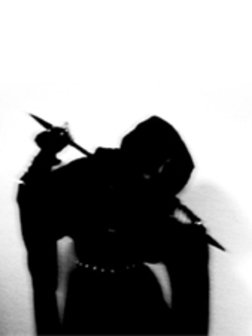





















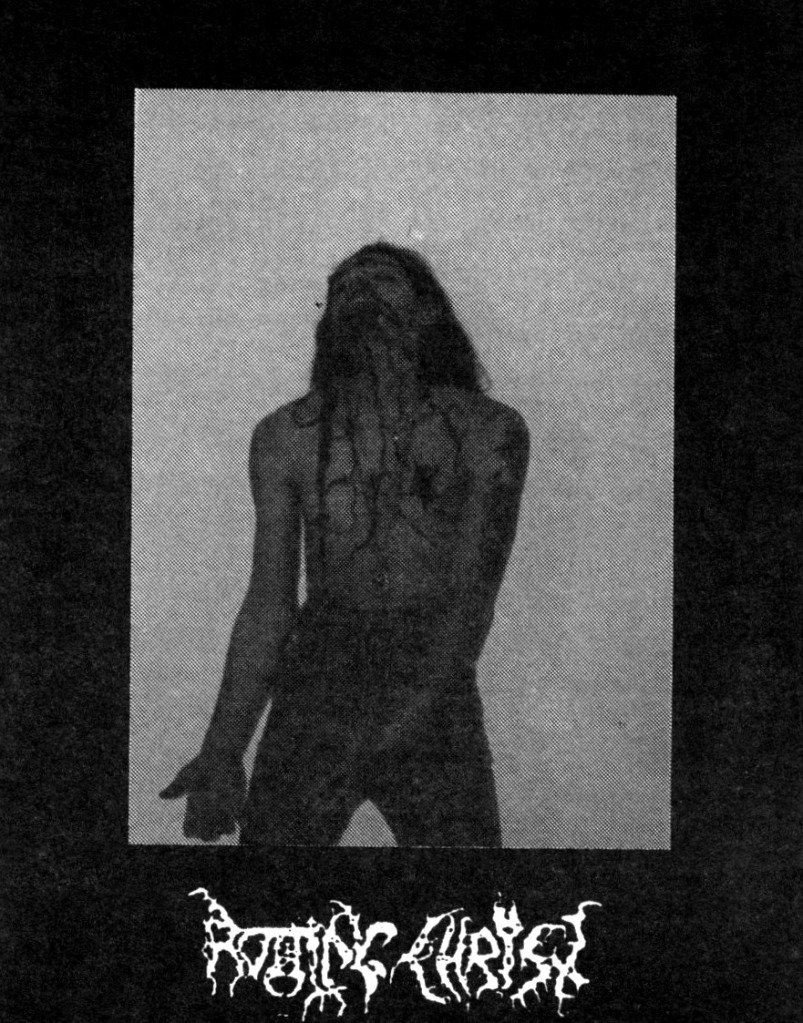



















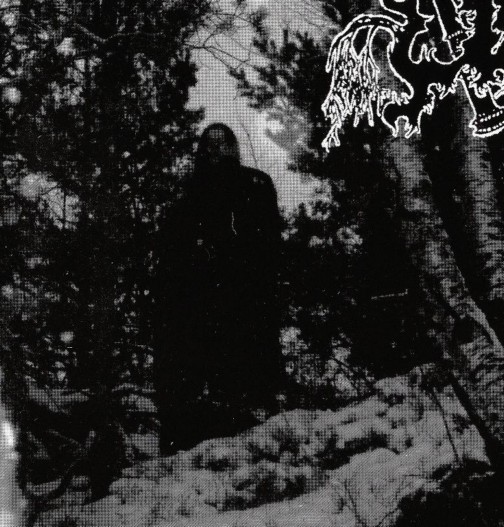






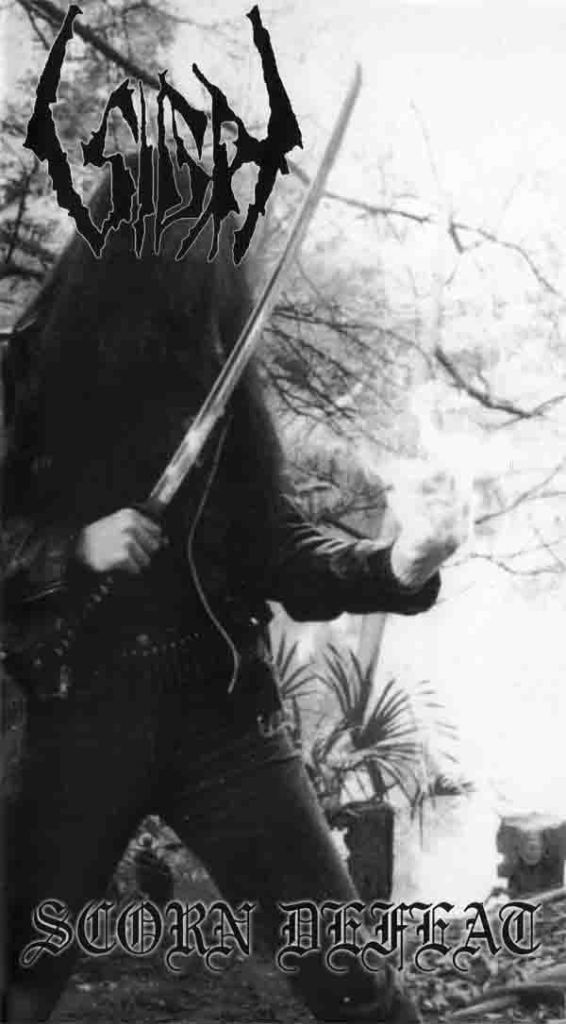







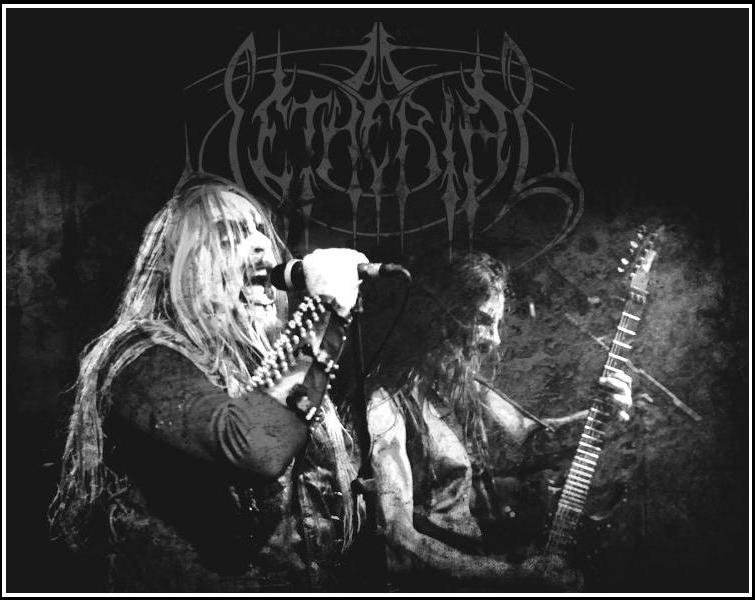










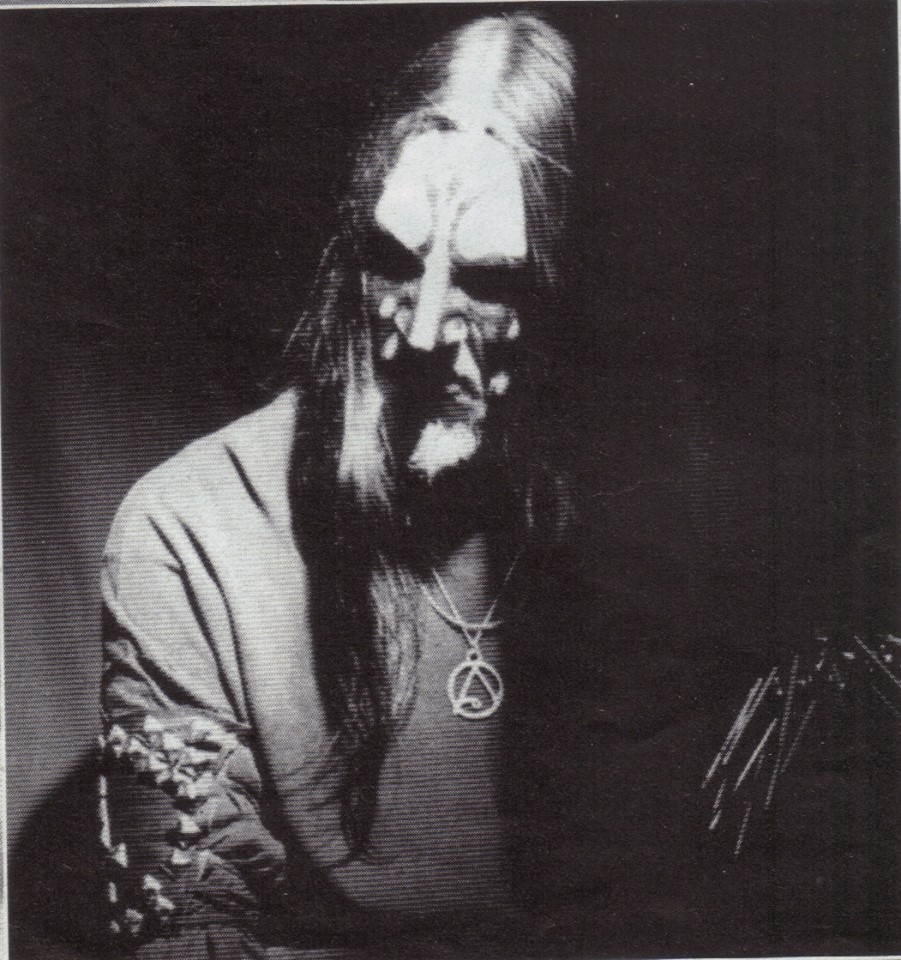

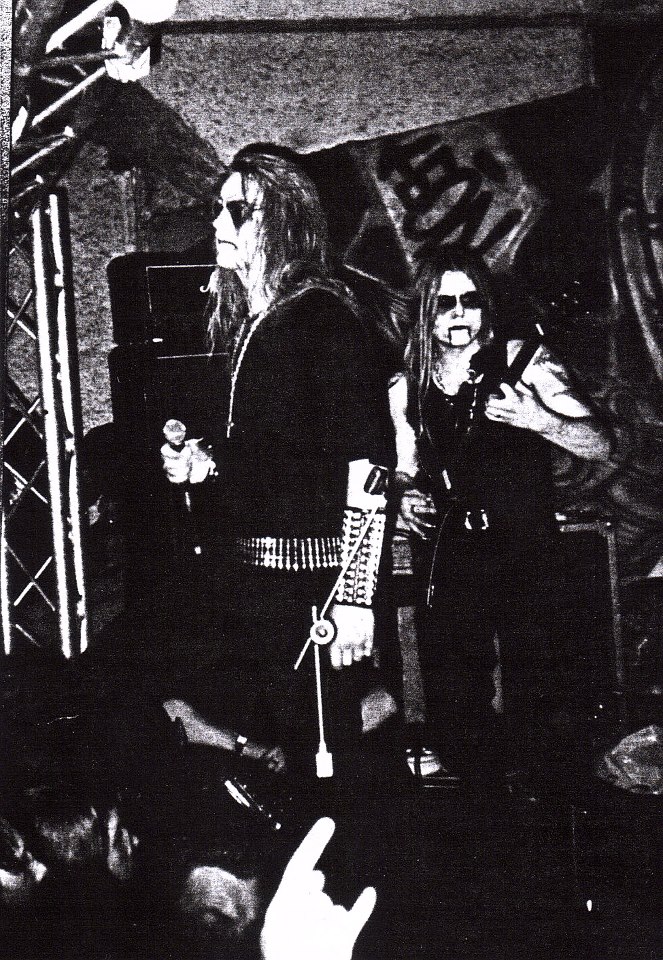











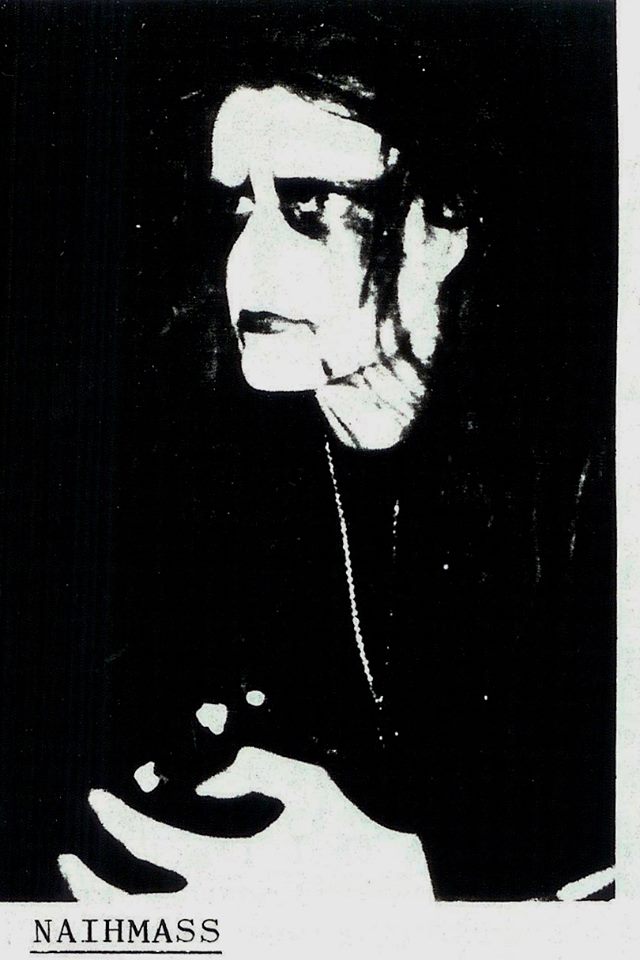



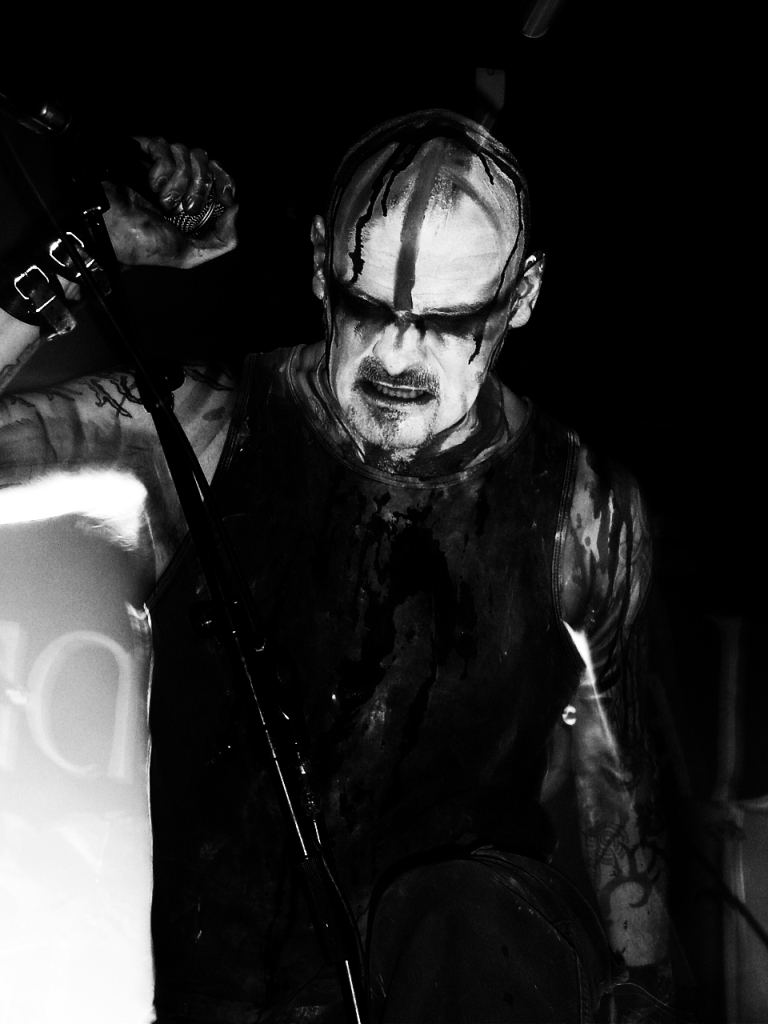




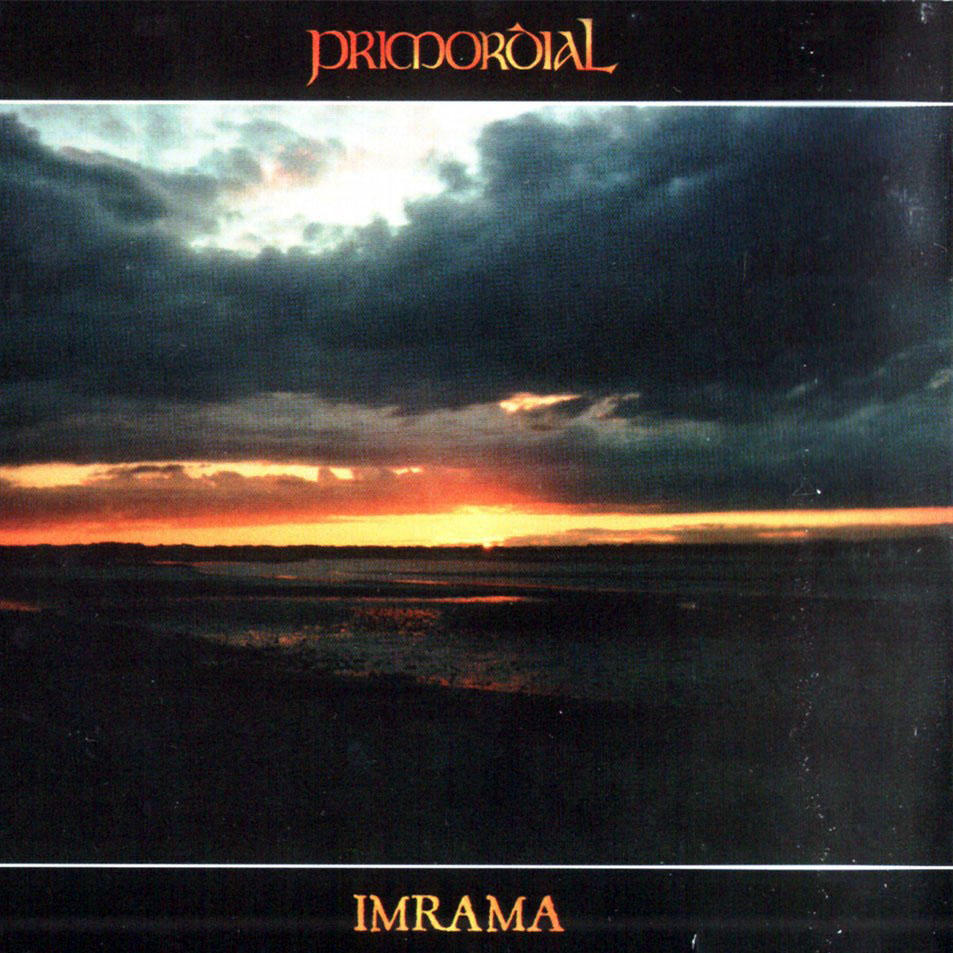








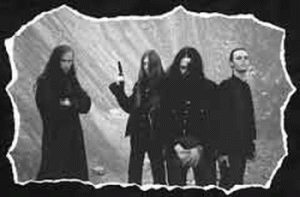








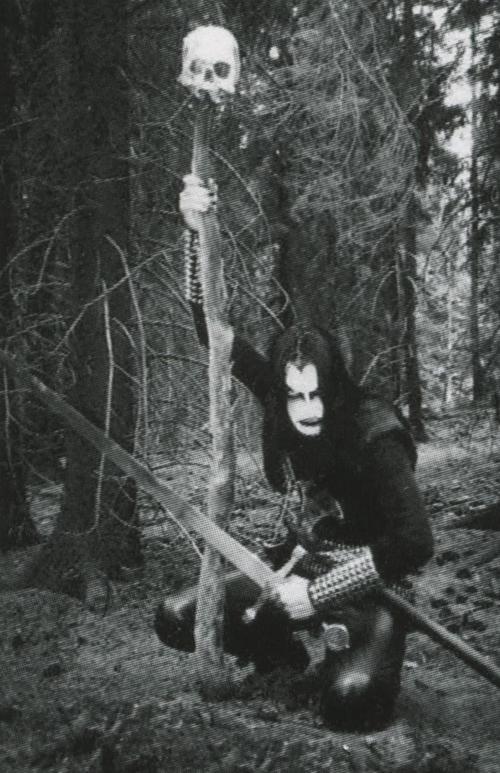



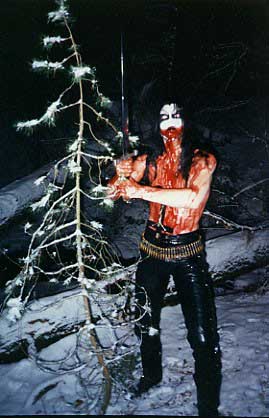
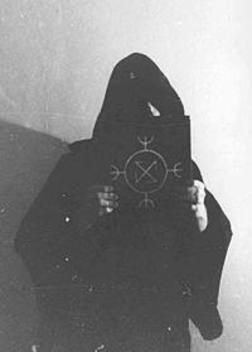












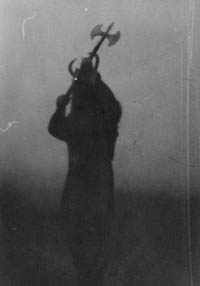






















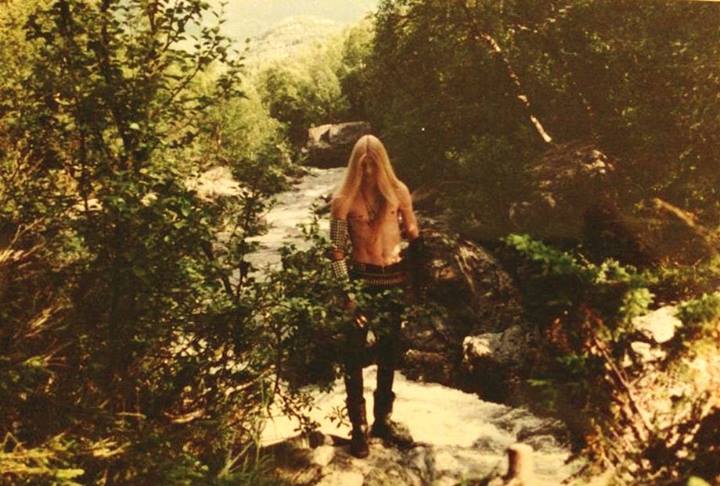


















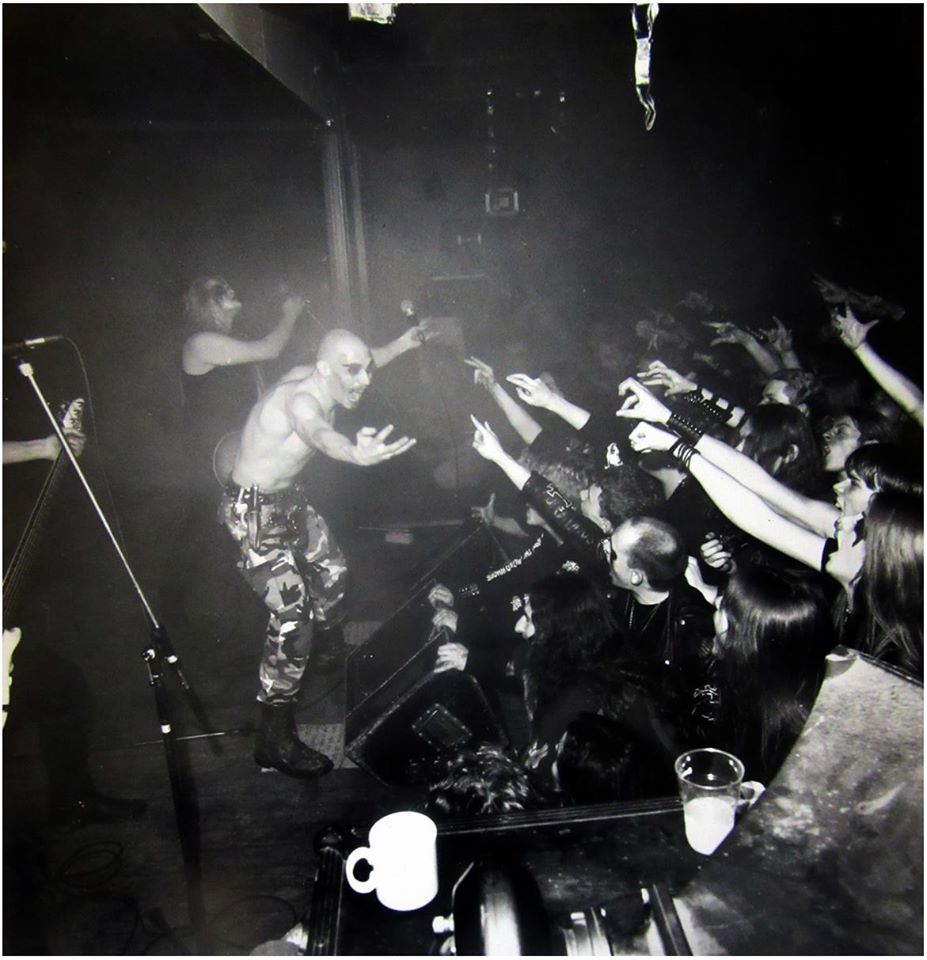






















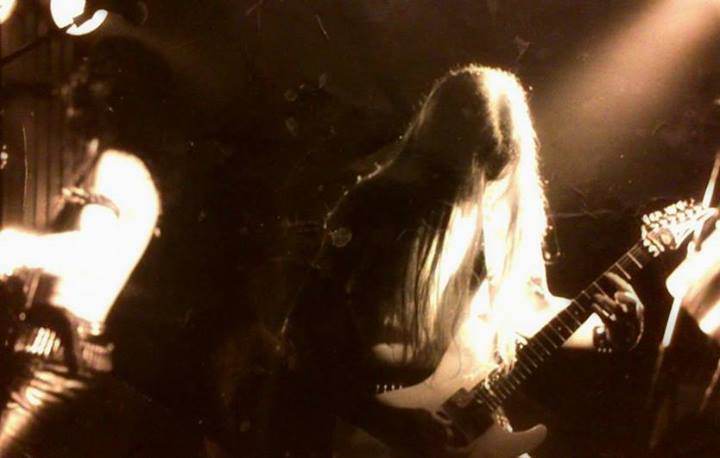





























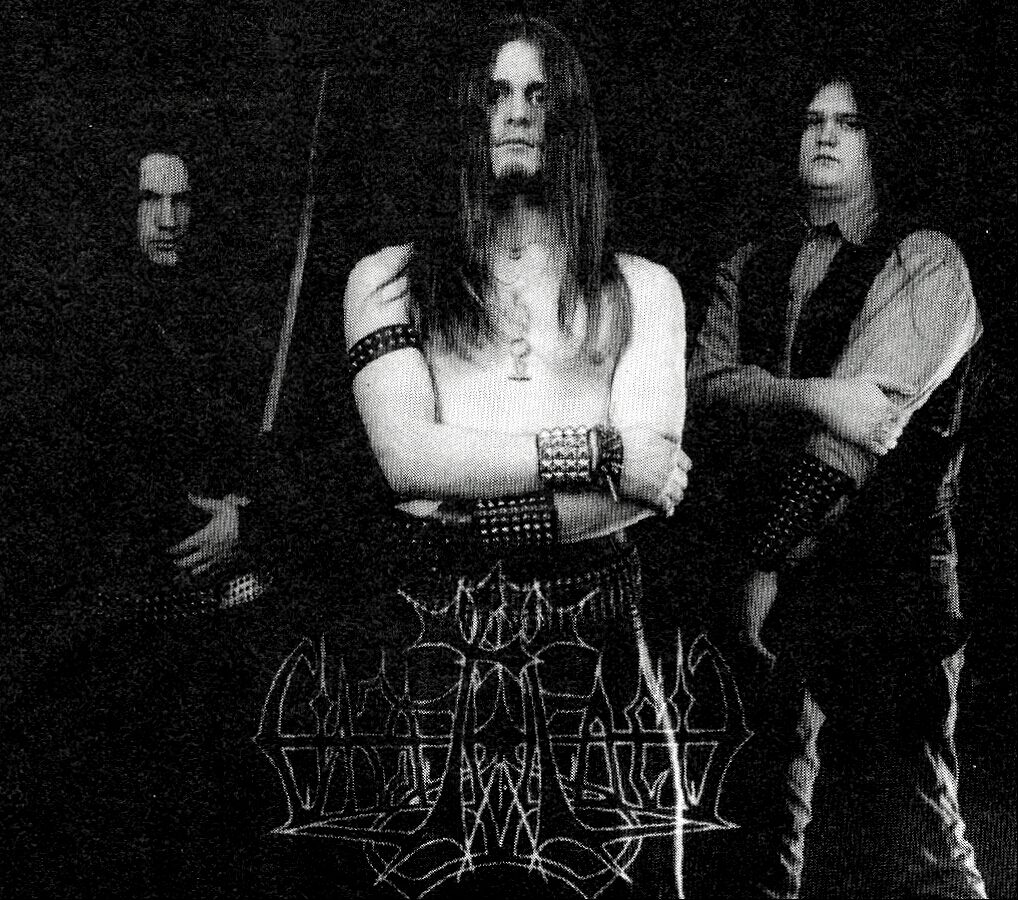













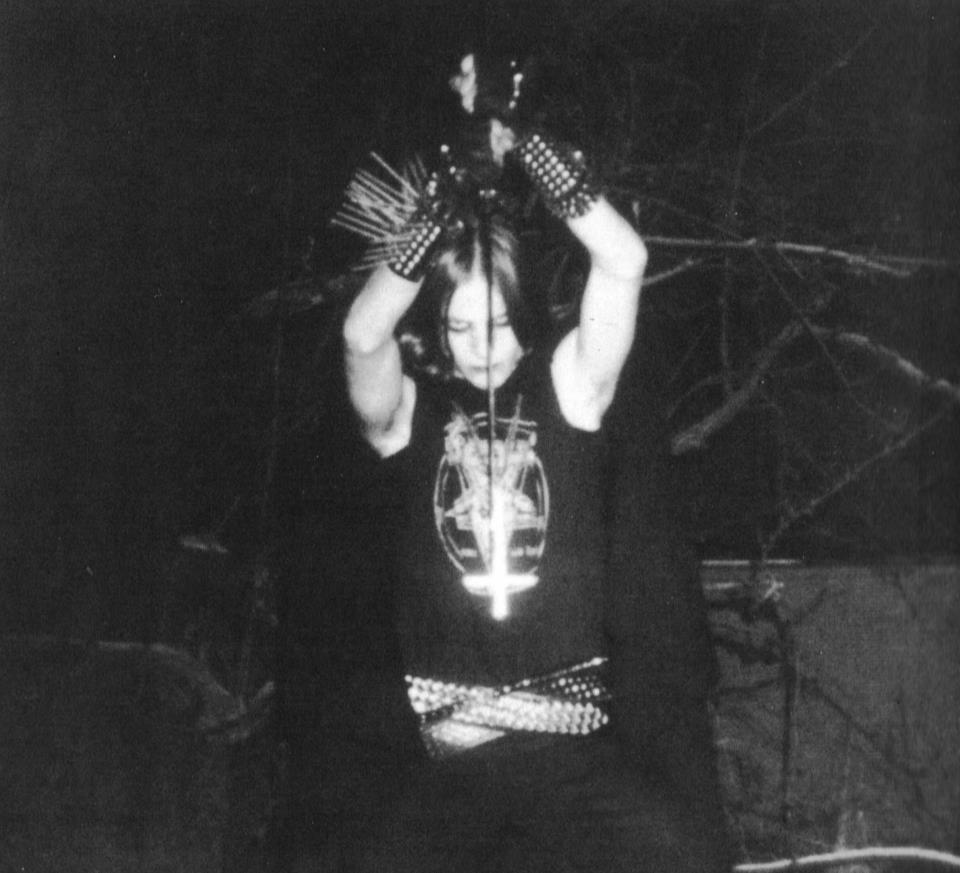

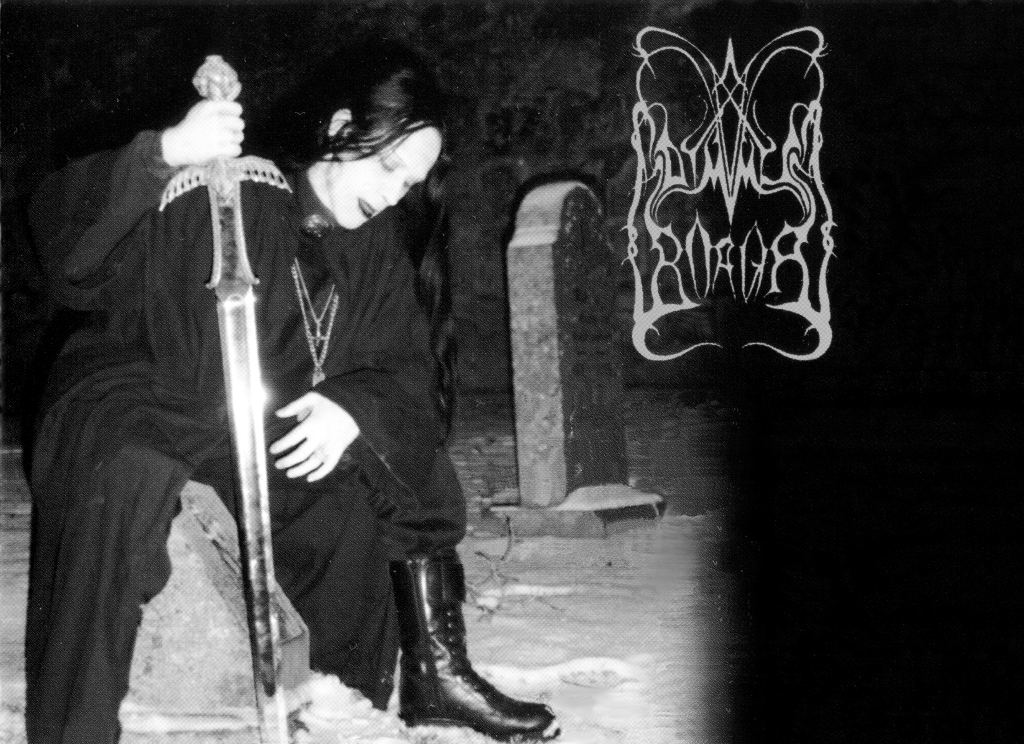








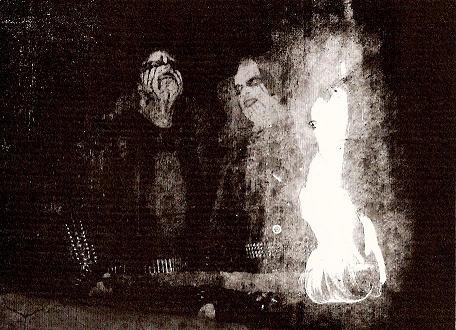


























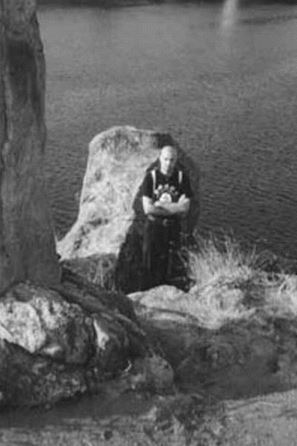


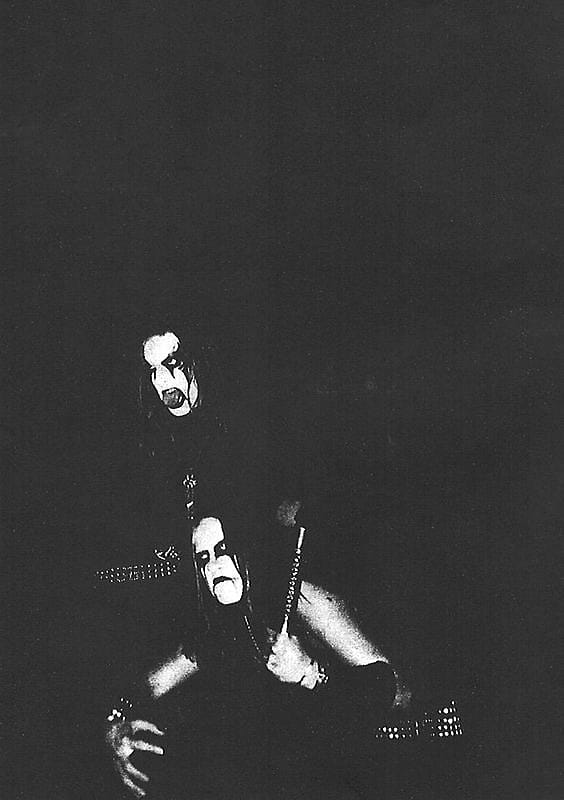





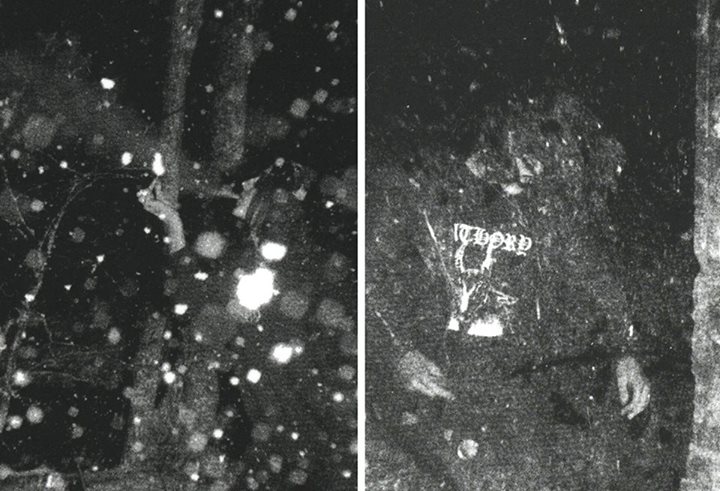












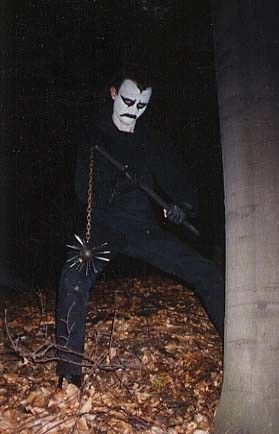





































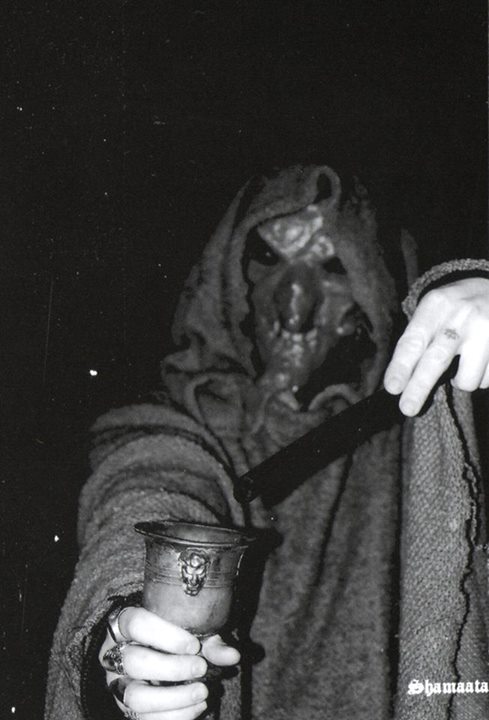



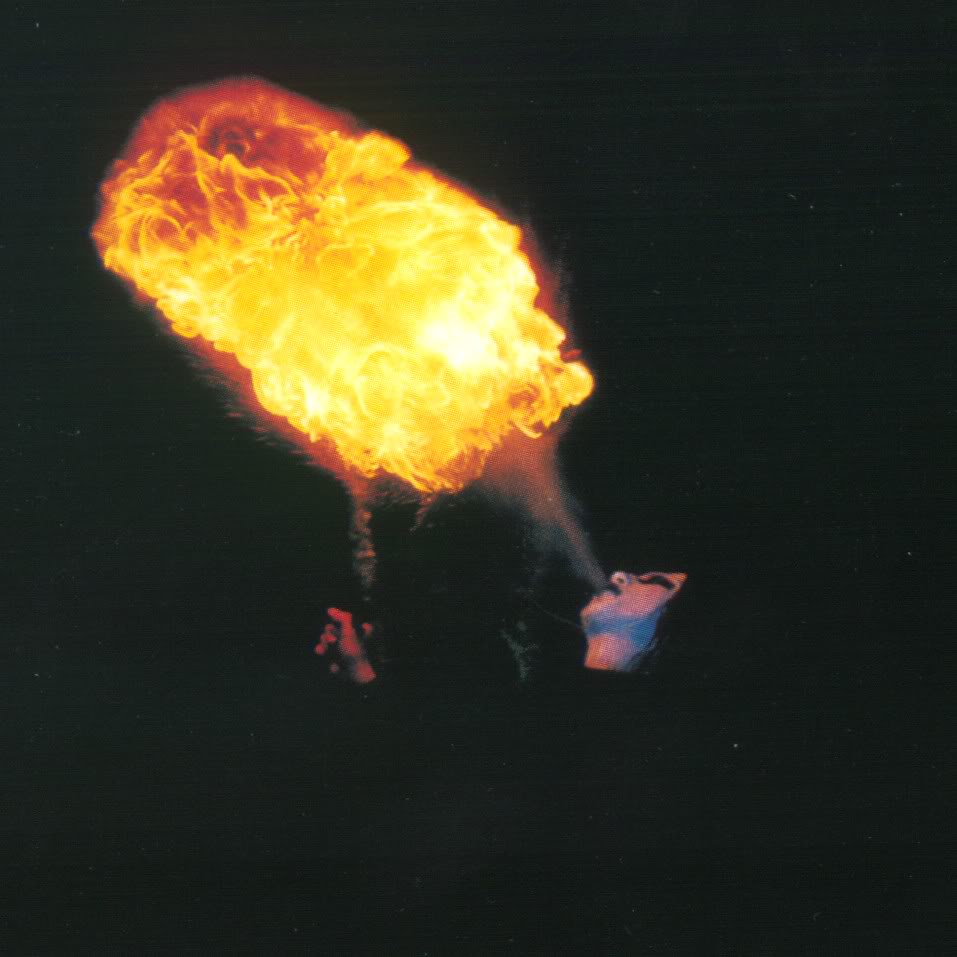







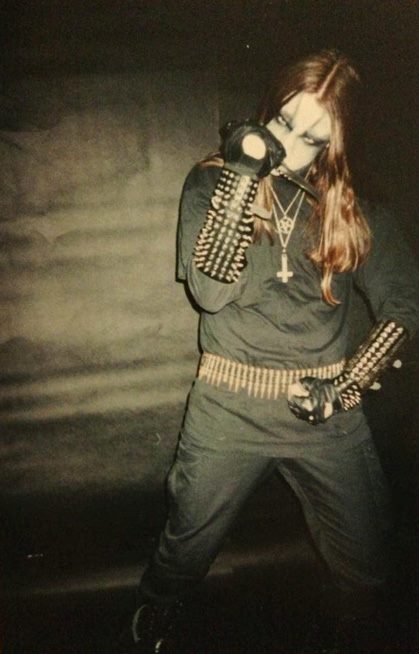










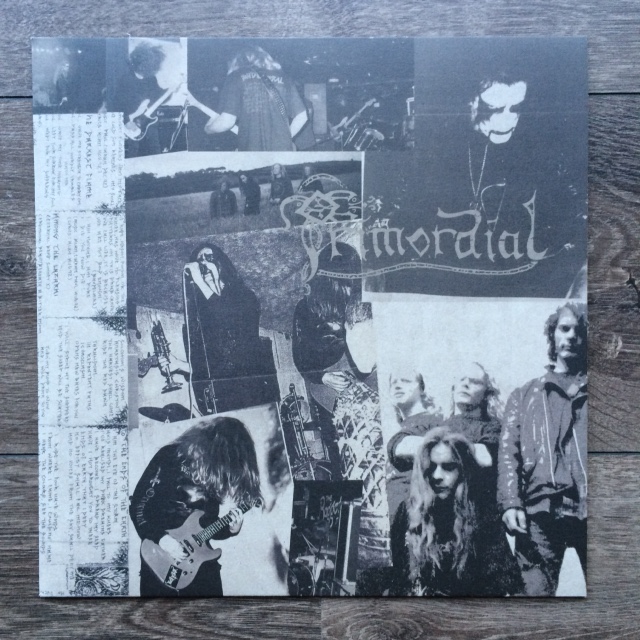


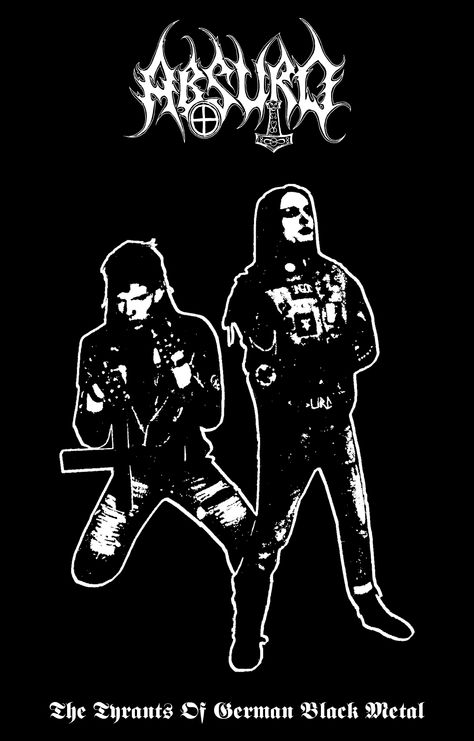

















A playlist with a song from each album in chronological order can be found HERE
1981:
Venom- Welcome to Hell 12/1/81
1982:
Venom- Black Metal 11/1/82
1983:
Metallica- Kill ‘Em All 7/25/83
Hellhammer- Triumph of Death 7/83
Slayer- Show No Mercy 12/3/83
Hellhammer- Satanic Rites 12/31/83
1984:
Hellhammer- Apocalyptic Raids 3/7/84
Slayer- Haunting the Chapel 6/84
Bathory- Bathory 10/2/84
Destruction- Sentence of Death 11/10/84
Celtic Frost- Morbid Tales 11/84
1985:
Sodom- In the Sign of Evil 1/85
Death Strike- Fuckin’ Death 1/85
Slayer- Hell Awaits 3/12/85
Destruction- Infernal Overkill 5/24/85
Bathory- The Return 5/27/85
Celtic Frost- Emperor’s Return 8/15/85
Possessed- Death Metal 10/16/85
Celtic Frost- To Mega Therion 10/27/85
Sepultura- Bestial Devastation 12/1/85
Master- 1985 Demo 85
1986:
NME- Unholy Death 1/28/86
Kreator- Pleasure to Kill 4/1/86
Massacre- Aggressive Tyrant 4/6/86
Morbid Angel- Abominations of Desolation 4/86
Sodom- Obsessed By Cruelty 5/9/86
Slayer- Reign in Blood 10/7/86
Sepultura- Morbid Visions 11/10/86
Repulsion- Slaughter of the Innocent 86
1987:
Pentagram- Demo #1 1/87
Necrophagia- Season of the Dead 2/1/87
Necrovore- Divus De Mortuus 3/87
Bathory- Under the Sign of the Black Mark 5/11/87
Death- Scream Bloody Gore 5/25/87
Napalm Death – Scum 7/1/87
Mayhem- Deathcrush 8/16/87
Sarcofago- I.N.R.I. 8/87
Pentagram- Demo #2 9/87
Sepultura- Schizophrenia 10/30/87
Sodom- Persecution Mania 12/1/87
Morbid- December Moon 12/87
Necrodeath- Into the Macabre 87
1988:
Nihilist- Premature Autopsy 3/88
Bolt Thrower- In Battle There Is No law 6/12/88
Carcass- Reek of Putrefaction 6/88
Slayer- South of Heaven 7/5/88
Rigor Mortis- Rigor Mortis 7/19/88
Pestilence- Malleus Maleficarum 9/26/88
Bathory- Blood Fire Death 10/8/88
1989:
Sepultura- Beneath the Remains 4/7/89
Autopsy- Severed Survival 4/24/89
Morbid Angel- Altars of Madness 5/12/89
Obituary- Slowly We Rot 5/16/89
Repulsion- Horrified 5/29/89
Blood- Impulse to Destroy 8/4/89
Nihilist- Drowned 8/89
Paradise Lost- Frozen Illusion 8/89
Rigor Mortis- Freaks 10/16/89
Bolt Thrower- Realm of Chaos 10/28/89
Pestilence- Consuming Impulse 10/89
Carcass- Symphonies of Sickness 11/4/89
Godflesh- Streetcleaner 11/13/89
Terrorizer 11/13/89
Nihilist- Only Shreds Remain 89
Tormentor- Anno Domini 89
Blasphemy- Blood Upon the Altar 89
Do you think there is some relationship between the dark extreme myths of Scandinavia’s past heroes and gods and the dark extreme music now generated from these lands? Are the echoes of the past still influencing this music?
The Viking blood still runs through our veins, the Semite-socialistic Christians have systematically destroyed our culture, religion (cosmology really) and everything belonging to the Germanic tribes. Even our myths are twisted and corrupted. Nevertheless we are Germanic in thinking and behaving thereafter. It is not echoes from the past it is echoes from ourselves! The archetypes awake within us. Aye, we are proud of our heritage but it’s our blood that has begun boiling again, with fury and self-respect. This is our awakening. The return of Wotan.
I think the dedication on the “Hvis Lyset Tar Oss” album was to Fenriz of Darkthrone. Is so, can you tell me why you dedicated the album to Fenriz in particular?
“Hvis Lyset Tar Oss” is dedicated to my brethren Fenriz and Demonaz. Skalds of the north, following the brown lamp and its chieftain”. This is what is written on the inner sleeve. Why? Fenriz and Demonas have supported me all the way with Burzum/Cymophane. Fenriz is also one of the wave to appear, up from the ashes of Wotan’s Reich. The Norwegian heathen undemocratic Front and Cymophane world-wide.
Can you explain the meaning of the lyrics on “Hvis Lyset Tar Oss”?
It’s a concept album about what once was before the light took us and we rode into the castle of the dream. Into emptiness. It’s something like; beware the Christian light, it will take you away into degeneracy and nothingness. What others call light I call darkness. Seek the darkness and hell and you will find nothing but evolution.
Do you write purely because it pleases you or are trying to touch those with similar instincts world-wide?
Both reasons really. Not world-wide but in lands with a similar heritage to mine, or to people with the same heritage. Non Germanic people won’t comprehend to what the hell I’m talking about anyway. So mainly in Europe.
Would you like to be remembered in a hundred years time? Why or why not?
It depends on what I’m to remembered as or for. It’s not a goal in itself to be remembered. It’s far important what one actually accomplishes. I don’t want to be remembered as one of the last Vikings, but as one of the new worlds rise! As I said before; “The return of Wotan!”
I believe you feel strongly about Odin your god. But there are other Norse gods. Why do you hold Odin in highest regard of all the gods?
There are no Norse gods, we have our Aeser and Asynjer. God is a Christian word. I believe in the spirit and the soul of Wotan (Odin is the Norse name for the German Wotan). The Germanic race is what’s left of Odin/Wotan. We are all one – the body of Wotan. Odin/Wotan is the father of all the Aeses. The king of all chieftains. The others are different sides of Wotan… Loke his shadow side, Hod his blind side and so forth. The so-called gods are symbols of Germanic ideas and values. Odin is the Ase of eloquence, magic and wisdom, of war and death. He is what I seek in myself as a Norse man.
Odin and our Celtic god Lugh are both patrons of poetry, innovation, travel and it has been said that they are the same being, worshipped under a different name by two cultures. Do you think this possible? If so can you see any other similarities between us Celts and you Norsemen?
The Swedes call him Oden, the Icelanders call him Odhinn, the Norwegians and Danes call him Odin, the Germans call him Wotan, the English call him Woden and their may be other names for him as well. I call him Wotan, for that is his oldest name (and we all originate from northern Germany), We are all one. I know very little about your Celtic paganism, so I cannot see the similarities between the Celts and Norsemen all to well. But of course there may be some…
Would you like to live in Valhalla when you die?
My interpretation of Valhalla is very different to the Christian one (we have no Germanic records of it). I am now in the hall of battle, we are all there…
Can you see Burzum ever touring? Would you like to tour?
No and no. Burzum is not a live band. I will never say never, but I doubt it will ever happen. I strongly dislike concerts.
Despite the criticism you have encountered, Burzum retain a healthy and growing body of support. Some bands spurn popularity what is your view on this? Would popularity bother you?
I think popularity just for the sake of popularity is ludicrous! If people like what I do, be it musically or ideologically, it is nothing but fine. Such popularity only tells me that there are people out there who appreciate what I am doing. Why the hell should I spurn such popularity? I would have to spurn myself and I don’t. All support is good support, and we need support to overthrow the Christian kingdoms. Burzum is a movement not a band.
Do you think black metal will exist for a long time to come?
Until the end of the world as it is today, perhaps beyond… We are here to stay, maybe the newer bands will wimp out. But Darkthrone and Burzum are doomed to opposition against this world by our very own ability to think. This goes for a lot of our supporters too.
What would you need to do in life to fulfill your greatest dream?
I’ll answer this question partly by quoting Josef Goebbles as the two of us don’t have a common goal, but the quote suits fine; “We shall reach our goal, when we have the power to laugh as we destroy, as we smash what ever was once sacred to us tradition, as education and as human affection. Perhaps you will see what our goal was when it is reached, or perhaps you will lie lifeless in a track of blood…” The weaklings will perish under the Cymophane.
Would you like to say anything else to anyone else?
I will encourage the proud Celts to contact “Up From The Ashes” (5 Rue Gabreil Pierne, 57000 Metz, France) and join us. Only the elite need pay attention to this, we are the tomorrow where Wotan reigns. Smash the weak, the inept, the stupid, the hypocrite and the enemy of nature. Strife is evolution, peace is degeneration.
You have now served about seven months of your sentence now, how have they been treating you?
I have served 17 months of my sentence not 7. 1 never complain and I abstain from saying anything good about the police/prison powers, so there is not much to tell. The treatment varies from guard to guard, from director to director.
Have your beliefs in the Norse race faltered? Why or why not?
Why should it? I do not think that the word “believe” is satisfactory. To believe is cowardish, to have trust in or to know is another thing though. In this connection, I must say no, my beliefs in the Norse people have not faltered. Actually it is not correct to talk about a Norse race. I talk about the white Aryan race, but the Norse-Germanic people. Included in the race is the also the Celt people, the Roman people and the Slavic people amongst others. Well back to your question; you ask why not. All I have to do is think logically and my views are strengthened. The more contact I have with non Norse-Germanic people, the more I have trust in Norse-Germanic people. The fact that Norway turned down the EU membership proposition is clear proof of our sovereignty to the other white Aryan peoples of the Old World. Nuke Brussels!
Have you had time to read and to think, have you been reading anything interesting lately? Has this helped you to develop any interesting ideas or philosophies? If so could you share any of these theories with us?
Nothing particularly interesting, but I have read books lately which were interesting. Like a book called “The masks of Odin” which reveals a theoscopic view on Norron (Norse) mythology. Also “Idunns Epeler” (The apples of Iduun) is quite interesting, dealing with the meaning of apples throughout the history of Europe and Scandinavia.
In the restricted conditions you now suffer, can you still write music and lyrics? If so can you describe this music and do you plan to release it?
Aye, I can write both music and lyrics. The music and what I plan to do with it will remain unclear until anything perhaps is released. No need to awake any expectations or such for now.
Are you pleased with the interest in “Det Som En Gang Var” on its second release? Are you still happy with that album?
As I have nothing to do with the sales of that album I do not know what interest there may be for it. As a matter of fact, I don’t really care! I make music mainly for myself and not for others. I release it simply because there are people who want to release it and I see no harm in that. Aye, I’m still happy with the album but I must say that it’s strange to release an album two and a half years after it was first released (in 1000 copies). Also, “Filosofem” is already two years old, and still not released. Strange.
On “Filosofem” the fifth Burzum release, there are deliciously insidious sound effects plus another epic keyboard piece. Describe the atmosphere you are frying to evoke on this album. Do you think it will attract listeners outside the black metal genre?
What effects? I do not remember using any effects on the album apart from using a headset microphone for the vocals [note – adds to the suggestion that the Filosofem guitar effect was added later by Pytten, but then why does “Once Emperor” have that effect? – Rainer]. Well I have no interests in saying anything at all about the album as anybody interested may listen for themselves whenever the album may be out. The “traditional black metal genre”? If you think twice you might remember that Burzum has never been promoted as “black metal” by my label. I usually do not care who listens to my music, but I would prefer that nobody from the “black metal” scene listens to Burzum, as the “black metallers” tend to be a bunch of pubertal losers with a strong feeling for inferiority. I dislike vehemently such low life. Burzum is not for weak losers with dyed black hair. Burzum ist nur für Arier! I do not know about Europe, but in Scandinavia and on Iceland mostly so-called normal people listen to Burzum. And of course, unfortunately the black metal losers listen to it as well.
Does evil exist?
For idiots yes, for others no.
Have you any goals or aims? What are they? Will you fulfil them – even if this takes until the end of your sentence?
Maybe, maybe not. But anyway I won’t tell you about it, or anyone else for that matter!
Is it possible for you to maintain a sense of humour in your situation? Do you think this is important?
I do not see why my “situation” should differ from anyone else’s as to whether humour is important or not. I see no point in discussing my private life with anybody but my closest friends. …So I won’t.
Do you take condoms with you from the visiting room, every time that you have visitors? If so what do you do with them?
I cannot take anything with me from the visiting room as they practice very strict security here. When we end the visit and return to our cells, we first have to undress, open our mouths and lift our tongue to see if anything is hidden there. Lift our arms, shake our heads so that anything hidden in the hair should fall out, lift our manly limb, and sit down in the hockey position so that anything we may have hidden up our arses may have fallen out! Also we have to put on a new set of clothes before we are allowed back into our cells. All this is done in a special room with mirrors on the walls. Later when they have checked our clothes very inch, we get them back.
What, at this point, is your message to mankind?
88
In 1992, members of the Norwegian black metal scene began a wave of arson attacks on Christian churches. By 1996, there had been at least 50 attacks in Norway; in every case that was solved, those responsible were black metal fans. Some of the buildings were hundreds of years old and seen as important historical landmarks. The first was Norway’s Fantoft Stave Church, which was burnt to the ground in June 1992. Police believe Varg Vikernes of Burzum was responsible. The cover of Burzum’s EP Aske (“ashes”) is a photograph of the destroyed church. On 16 May 1994, Vikernes was found guilty for burning down Holmenkollen Chapel, Skjold Church and Åsane Church. In addition, he was found guilty for an attempted arson of a fourth church, and for the theft and storage of 150 kg of explosives.
To coincide with the release of Mayhem’s De Mysteriis Dom Sathanas, Vikernes and Euronymous had allegedly plotted to bomb Nidaros Cathedral, which appears on the album cover. The musicians Samoth, Faust and Jørn Inge Tunsberg were also convicted for church arsons. Those convicted for church burnings showed no remorse and described their actions as a symbolic “retaliation” against Christianity in Norway. Mayhem drummer Hellhammer said he had called for attacks on mosques and Hindu temples, on the basis that they were more foreign. Today, opinions on the church burnings differ within the black metal community. Many, such as Infernus and Gaahl of Gorgoroth have praised the church burnings, with the latter saying “there should have been more of them, and there will be more of them”. Others, such as Necrobutcher and Kjetil Manheim of Mayhem, see the church burnings as having been futile, with the latter claiming that many arsons were “just people trying to gain acceptance” within the black metal scene.
The following is a partial list of the church arsons:
1992
23 May: attempted burning of Storetveit Church in Bergen.
6 June: burning of Fantoft stave church in Bergen – Varg Vikernes is strongly suspected as the culprit, but was not convicted.
1 Aug: burning of Revheim Church in Stavanger.
21 Aug: burning of Holmenkollen Chapel in Oslo – Varg Vikernes and Faust were convicted for this; Euronymous also participated, but was murdered in August 1993.
1 Sep: burning of Ormøya Church in Oslo.
13 Sep: burning of Skjold Church in Vindafjord – Varg Vikernes and Samoth were convicted for this.
3 Oct: burning of Hauketo Church in Oslo.
24 Dec: burning of Åsane Church in Bergen – Varg Vikernes and Jørn Inge Tunsberg were convicted for this.
25 Dec: burning of a Methodist church in Sarpsborg – a firefighter was killed while fighting this fire.
1993
7 Feb: burning of Lundby New Church in Gothenburg, Sweden.
1994
13 Mar: burning of a church in Sund.
27 Mar: burning of Seegård Church in Snertingdal.
16 May: attempted burning of Gol stave church in Buskerud.
17 May: attempted burning of Åmodt Chapel in Buskerud.
4 Jun: burning of Frogn Church in Drøbak.
19 Jun: attempted burning of Heni Church in Gjerdrum.
7 Jul: burning of a church in Jeløy.
21 Jul: attempted burning of Odda’s Church.
13 Aug: attempted burning of Loop Chapel in Meldal.
10 Dec: attempted burning of Åkra Church.
22 Dec: attempted burning of Askim Church.
26 Dec: attempted burning of Klemestrud Church.
1995
13 May: burning of Lord Church in Telemark.
25 May: burning of Såner Church in Vestby.
14 Jun: burning of Moe Church in Sandefjord.
21 Jul: attempted burning of a church college in Eidanger.
3 Sep: attempted burning of Vågsbygd church college in Kristiansand.
3 Nob: burning of Innset Church in Rennebu.
“We were repulsed by music about love and kindness – we just hated it,” says Jan Axel Blomberg, drummer for the pioneering Norwegian black-metal band Mayhem, who is known better by the name Hellhammer. “We wanted to make music that was the extreme opposite of that.”
“I guess there’s a lot of good things in life,” offers vocalist Attila Csihar, who pronounces his last name “chee-har” in a thick Hungarian accent. “The sun comes up every morning, and it’s beautiful, and there’s nature and family. But if you look at what’s going on in the world … we are living in a nuthouse with fucking wars and governments controlling people. So it has been my personal path to understand and embrace the darkness.”
More than 20 years ago, Mayhem put out an album that radiated the sort of angst that spoke to Hellhammer, Csihar and their bandmates at the time: De Mysteriis Dom Sathanas, the title of which roughly translates to “Lord Satan’s Secret Rites.” Its lyrics speak of growing darkness, bottomless hellholes, pagan fears and the undead returning to recount their damnation. It’s pure Stoker with a side order of Poe, uniquely orchestrated to caterwauling gothic guitar and death-rattle drums and topped by Csihar’s avant-garde combo of growls, grunts and operatic howling. And it set the tone for musical extremism for a generation, inspiring legions of disaffected headbangers to dress in black and hail Satan literally. But for all its importance and mythos, the group was never able to tour behind it.
After spending most of the Eighties refining their sound and weathering lineup changes, Mayhem had found a steady groove by the Nineties and a consistent membership with vocalist Dead (real name: Per Yngve Ohlin), Euronymous, Necrobutcher (Jørn Stubberud) and Hellhammer. They’d previously put out a death-metal–leaning EP, Deathcrush, with a prior lineup and by 1991 they were previewing their full-length debut, De Mysteriis Dom Sathanas, in the metal press. “We won’t delay it anymore unless something extreme happens,” Euronymous told Slayer magazine at the time, as he reported they were still writing about three more songs. His examples of things that could be radical enough to halt progress on the LP were “if Hellhammer disappears again, if Dead cuts himself too much at a gig or if I lose my passport in Albania.”
He was referencing the group’s recent tour of mainland Europe, which Hellhammer remembers as particularly arduous. “It was horrible,” he says. “It was the worst experience in my whole life actually.” The band had decided to travel via the continent’s robust rail system, rather than with a bus, with all its equipment. Hellhammer remembers having his money stolen and nights without a place to sleep. In Turkey, police arrived at the gig with machine guns and shut off the group’s power. “I could never do it again,” he says.
Onstage, it was another kind of horror: Dead wore black-and-white face paint that has become known as “corpse paint” to evoke the look of death and he reputedly buried his stage clothes to give them a death-like aroma. “We had some impaled pig heads, and I cut my arms with a weird knife and a crushed Coke bottle,” the singer told Slayer of one gig in an interview compiled in the book Metalion: The Slayer Mag Diaries. “We meant to have a chainsaw but the guy who owned it had left when we came to get it. That wasn’t brutal enough!”
Regardless, the tour gave the group a chance to test-drive some of its new material. The album Live in Leipzig, recorded in Germany in 1990, captured the group performing four De Mysteriis songs with Dead onstage. As fate would have it, though, he would record only one of them in a studio. In April 1991, he committed suicide by slitting his wrists and throat and then turning a shotgun to his head. The first line of the suicide note read, “Excuse the blood.”
Euronymous took photos of the scene before calling the authorities, which disturbed founding member Necrobutcher enough that he left the band. The guitarist filled the bassist’s vacancy with Vikernes – who recorded black-metal LPs as the one-man band Burzum for Euronymous’ Deathlike Silence Productions record label – and he dispatched a typewritten letter that year to Csihar, Dead’s favorite singer, who lived Hungary. The guitarist told Csihar he had two initiatives for writing: an opportunity to put out the Anno Domini album the singer recorded in the mid-Eighties with the thrashy black-metal group Tormentor and to ask if he would want to perform Dead’s lyrics in the studio. “They loved my stuff,” Csihar says. “It was great.”
Csihar had formed Tormentor in Budapest in 1985, inspired by tapes of metal bands that his friends had smuggled into the communist country. The genre of black metal had gotten its name from Venom’s gritty yet campy 1982 thrash LP Black Metal, and groups like Celtic Frost and Bathory respectively gave it a pummeling and classical-music–inspired sinister quality in subsequent years. Tormentor picked up that mantle with ornate flourishes and an eerie atmosphere – best heard on “Elisabeth Bathory,” a song about a Hungarian countess who reportedly bathed in virgins’ blood.
He listened to Deathcrush, “which was like, ‘OK, cool,’” but he was sold on working with the group – which wouldn’t happen for another one-and-a-half years – when he heard early versions of the De Mysteriis songs. “I was like, ‘Fuck, this is great,’” Csihar recalls. “It is going to be something new. It sounded futuristic. It sounded modern and very dark and cool.”
That new sound was in part due to Euronymous experimenting with another Norwegian black-metal guitarist, Snorre Ruch, who went by the name of Blackthorn, and led the group Thorns. Many in the Norwegian black-metal scene credit Ruch with being the first to do away with the thrash- and death-metal guitar style of playing chunky, chugging chords in favor of a looser, darker sound. “I was listening to classical orchestral music and the tonal progression in some of this music had a lot of drama and pathos,” Ruch says. “I experimented with minor chords and later added the super-fast picking I learned from Euronymous. It then developed to more dissonant chords and tonal progressions.”
Ruch was a member of Mayhem for only about three months, sometime after Euronymous had recorded the guitar for De Mysteriis Dom Sathanas, but his influence extended before then. “Thorns had reached a standstill and Euronymous and I had the idea of playing second guitar in each other’s bands for a while, but that evolved into merging my songs into Mayhem and canceling Thorns,” Ruch says. “This was interesting for me since Mayhem was a ‘well-working’ band and Thorns was not.” Nevertheless, two riffs from Thorns’ instrumental “Lovely Children,” the lead track on their Grymyrk demo tape, made their way into Mayhem’s “From the Dark Past.” “Some months later the internal chemistry in Mayhem was so bad that I did not care to participate any longer,” Ruch says.
The guitarist’s main contribution to De Mysteriis was editing some of Dead’s lyrics. “Dead had written lyrics and done vocals on four of the songs for the album, but he had also left behind some sheets with lyrics and ideas,” Ruch recalls. “My job was to make this work with the newer songs that did not [have] any vocal arrangement. Typically, I would change as little as possible. The challenge was to make the relatively short lyrics fit in rather long songs. I don’t remember much of this process, but I thought his lyrics were good.”
“Dead had a dark personality, I suppose, so his lyrics were all very scary, dark and eerie,” Hellhammer recalls. “It really reflected his personality. He really did kill himself later, so to speak.” He laughs. “So yeah.”
Dead explained in an interview with Slayer that he wrote the De Mysteriis tracks “Funeral Fog,” “Freezing Moon,” “Buried by Time and Dust” and “Pagan Fears” as a reflection of how he felt. “I can explain ‘Funeral Fog,’ it’s about a legendary place in the middle of the Carpathian horse shoe, a swampland called Shurlock Basin which is surrounded by fearful superstition and the weirdest beings are thought to haunt the place,” he said. “I started to imagine a heavy fog lit up by a full moon. This fog oozed up from that place, drifting woefully in silence to extinguish the lives of the local people and bring their souls to Lord Satan.”
He said “Pagan Fears” was about the idea that “the past isn’t dying but remains in some faded reality,” and the title track was about an “extraordinary evil coven” from a book that he’d apparently only heard about, but he expected to rewrite the songs. “I [decided] the lyrics weren’t evil enough and it didn’t describe the enormous force enough,” he said. In another Slayer interview, he said he needed to find the book that inspired the song “before some wimpy mainstream jerk” could. “I think I’ll have an expedition on my own around the world to find it,” he said. “It’s so dark, darker than death.”
One De Mysteriis song whose lyrics Dead did not write was “Cursed in Eternity,” which Necrobutcher – who’d written the band’s Deathcrush-era lyrics – penned. “At that time, I was heavy into books, and I read passages in a book about a shaman doing a ritual,” he says. “It’s about the shaman putting on a curse.”
Although Euronymous often gets credit for writing the album’s music, partially since the artwork contains photos only of Hellhammer and him (“We didn’t have photos of Attila,” Hellhammer explains), the band members have posthumously explained who wrote what. Necrobutcher wrote some of “Freezing Moon,” “Pagan Fears” and “From the Dark Past,” and both he and Hellhammer contributed riffs to “Buried by Time and Dust.” “And Varg did some interesting stuff with the bass there, which inspired Euronymous,” Hellhammer adds. “We just didn’t understand how copyrights or royalties and how the business worked, so I guess it was only Euronymous’ name on it. If it were today, the songwriting shares would be different.”
In sessions that spanned 1992 and 1993, the band, consisting of Euronymous, Vikernes and Hellhammer, converged on Grieg Hall – home to Bergen, Norway’s Philharmonic Orchestra – to record. The studio was located a few floors up in the building, but it had a low ceiling and Hellhammer thought it muted his sound. Then he went into the main hall, where a five-piece drum kit was set up, and loved the sound there. “I says to [engineer] Pytten, ‘I want my drums down there,’” says Hellhammer, who recalls being a big jazz fan at the time, inspired by Buddy Rich. “And he goes, ‘Ha, you’re crazy.’ ‘Yes, I am.’ And then he understood. We took the cable for the microphones and ran them down the elevator shaft.” They set up some candles down there and dimmed the lights and subsequently, De Mysteriis Dom Sathanas had one of the most powerful drum sounds in metal.
Eventually, they sent for Csihar in 1993, who arrived with his now–ex-wife. The country seemed like high society to him, but he was immediately impressed by the metalheads who picked him up at the airport. Vikernes was wearing chain mail. “I just hung out for a bit in Oslo,” Csihar says. “Back then, the cops were after everybody. And it was hard to survive because everybody was struggling. The scene was so small and very underground.” The band members shared their philosophies about religion and politics with Csihar, but he was more interested in dubbing albums from Euronymous’ and Vikernes’ record collections.
“It was cool – it was good times,” Csihar recalls. “It was pretty intense, too. Everybody was kind of high on fire somehow. This album had been going on for a long time, and I was the last part of it. So we rehearsed a bit and went to Bergen.”
In the time since the singer had fronted Tormentor, he developed a new, much more experimental singing style that he simply calls a “darker voice.” He’d gotten deep into the music of industrial group Skinny Puppy, especially their Too Dark Park and Last Rights albums, and drew inspiration from the husky growls of singer Nivek Ogre. He was also a fan of the dark balladeering of Current 93, the experimental wailing of Diamanda Galás and metal vocalists like Quorthon – frontman of early black-metal pioneers Bathory – along with more well-known singers like Ozzy Osbourne, Rob Halford, Ian Gillan and Uriah Heep frontman Dave Byron. But Csihar’s own vocal cords produced a deep, wraithlike croak that sometimes approximated the heavy throat-singing style he’d heard as a teenager on an adventure in Mongolia, when he and his friends would drink beer and sneak into monasteries. It was a far cry from Dead’s more straight-ahead approach.
“His vocals were something new, totally inverted and bizarre,” Hellhammer says. “It was grim and dynamic. You might not like it much but you can be fascinated by it. It takes time to understand what he’s doing and how he’s singing in different voices, and it really adds to the recording.”
“I once said that this album reeked big time, because the vocals ruined everything, but the truth is that I had only properly heard the vocals on ‘Freezing Moon’ … but the vocals on the other tracks are perfect,” Vikernes said in 2005. “I was used to Dead’s vocals and his way of singing, and I never wanted that to change. Attila … was more concerned about his ‘artistic integrity’ and didn’t want to sound just like Dead.”
Csihar recalls the band giving him a lot of space, both figuratively and literally, to get his vocals right. The studio he sang in was dark with curtains blocking the windows and only a few candles piercing through what he recalls as pitch-black darkness. “I got a hand mic so I could just fucking dance around and do whatever I wanted in the darkness, and no one could see me,” he recalls. “I was stuck in a trance in this dark room. I didn’t want the others to see me so I could cover it up so I could transform. I could shapeshift.”
Sometime after recording, Csihar departed back to Hungary, where he was a year away from a degree in electrical engineering, so he could resume his college studies. “My exams were coming up, and I didn’t want to fuck up the whole semester,” he says. “My plan was to skip the next semester and go back later, because Euronymous had some plans for touring. I was really looking forward to that.”
Csihar waited and waited to hear from Euronymous but never did. Eventually a friend of his told him that the guitarist had been murdered, but Csihar didn’t believe it until he read it in a magazine. “I was like, ‘What the fuck, that’s why nobody picks up the phone for two weeks now,’” he recalls. “‘That’s fucking insane.’
“I was really depressed,” he continues. “To lose someone like that it’s … We didn’t know each other that much, but we’d been in contact for a long time. We liked each other. It was losing a friend. And then on top of that, you’ve got a fucking great album and it wasn’t coming out. To release something in those days was hard, especially for me from Hungary in the early Nineties just at the end of the old system. I was like, ‘I hope to fuck finally I can be on an album after playing music for a decade.’”
All Csihar had was a five-song tape he’d made of rough mixes in the studio. It would later come out as a limited-edition EP called Life Eternal, but he would not hear the finished version of the album for over a year and would not hear from the band again until then.
Meanwhile, Hellhammer was trying to pick up the pieces of the band in Norway. In 1994, Vikernes received a 21-year sentence for murdering Euronymous, as well as for church arson; he has claimed that he was not guilty in the latter charge and that he killed Euronymous in self-defense. Ruch, who drove Vikernes to Euronymous’ apartment, was charged with being an accomplice to the killing and received an eight-year sentence. So with Csihar unreachable, as Hellhammer did not have contact info, the drummer became the sole remaining member of the group. “It was all up to me to make this record come out,” he says.
He connected with his friend Robin Malmberg of the group Mysticum and used rudimentary computer programs to make the album art. He had some lofty ideas for the packaging – lyrics written in calligraphy on parchment paper, the band’s name stamped in foil – but because of the budget, it became more stripped down. He picked the cathedral photo for the cover because Ruch given it to him and he thought it was cool. The only photos he had of the band were shadow portraits of himself, Euronymous and Csihar, and the only proper portraits he had were of himself and Euronymous, so those were the only credits listed in the album. The other reason, possibly for a lack of credits, was, as Hellhammer recalls, “Euronymous’ father didn’t want it to be released, because the killer and victim were on the same record.”
De Mysteriis Dom Sathanas finally came out in the spring of 1994, and its influence was almost immediately apparent.
Article by Pelagius, originally posted on Praefuscus Ferrum.
Open suggestions to be molded and modified by any individuals; this is a first push. Work in quiet, work in secret, work strictly locally. But spread the ideals of elitism above the simians.
1.1 Unconscious fostering of culture
Historically, black metal arises from the realist (a-social, a-political) view presented by early Black Sabbath (which was quickly perverted into money-making and covered up), the rebellious and harsh reactions of a young Tom. G Warrior (which disappeared as his music became more “acceptable”), and the satanic presentation symbol-layer enforced by Bathory. The strongest results and artists were born from inward-looking individuals sharing in an elitist but anti status quo mentality. This was fostered through organic though unconscious counter-culture.
1.2 Missing ideology
The counter-culture that is necessary as a basis for black metal to develop is opposed by a globalized and commercialized world. Pseudo black metal of the globalized present misses centrality and an inward-looking isolation; when thought of consciously, this usually can be boiled down to an ideology; ‘ideology’ is usually misunderstood and correlated with politics, but the word simply means “science and system of ideas”.
1.3 Missing quality
The opposite present problem is those groups effectively trying to separate themselves from the dross of humanity but which forget all about a holistic approach that brings about a flourishing culture capable of producing quality. Elitist mentality is left behind and instead a partisan and tribal mentality is adopted where sharing in a religion or political stance is enough for mediocre art to be accepted.
2.1 Antinomianism
From the Greek anti-nomos: ‘anti’ = ‘against’; and ‘nomos’ = ‘law’. Antinomianism = ‘against the law’. In the context of black metal as a counter-culture, it means believing to be outside the common ‘human-made’ law, or not recognizing it as relevant or valid.
2.2 Misanthropy
From the Greek misos-anthropos: ‘misos’ = ‘hate’ and ‘anthropos’ = man / human. Misanthropy = hatred for humanity. In the context of black metal as a counter-culture, it means feeling disgusted by the acts and nature of the majority of humanity as mediocre, dishonorable and all around foolish, weak and undeserving. This misanthropy is an opposition of what is ‘merely human’, or complacent and so mediocre; here is also cut whatever pseudo art is merely pandering to a religious or political tendency, or whatever is uplifted on the basis of authority rather than merit.
2.3 Mysticism
Stemming principally from the Greek ‘mystikos’ = ‘secret’ / ‘undercover’ / ‘underground’. Part of a group that requires membership to share information; typically a group sharing esoteric knowledge. In the context of black metal as a counter-culture, it means closing off circles to outsiders in the understanding that to understand the art and other in-group values, it is necessary for someone to (i) be part / participate of the counter-culture, and (ii) have certain necessary personal qualities that make a person receptive to the experience and knowledge that comes with it — that is, an esoteric knowledge that cannot be transmitted directly but is absorbed by several levels of experience.
3.1 Purpose
The purpose of creating a black metal circle is to foster the results of black metal counter-culture: the fundamental shift of mentalities through the creation of transcendental art. Taken to its logical serious consequences, black metal presents and needs a change of vision and mind with respect to society, taking the individual to stand at odds with it from a spiritual, not a political or even merely social, stance. The purpose is artistic, but beyond the artistic, and in the understanding that the essence of human experience underlies the social and the political, and does not consist of it. The purpose is transcendental, and forward-looking, to foster a different attitudes towards life and reality among those who are brave and intelligent enough.
3.2 Methods
We can briefly divide the methods to carry this out into in-group and out-group activities. In-group activities must focus in the creation of common experiences, and that these lead to common understanding particular to the group, as well as the creation of art that arises from them. This takes time. Out-group activities consist in the things that are projected towards outsiders, with the intent of artistic expression and survival, but also so that outsiders who contain the potential, can have the opportunity to know we exist. The out-group activity includes ‘propaganda’, which is commonly misunderstood by most people as meaning ‘political’. Propaganda is only the art of projecting a message towards groups of people, rather than simply individuals.
3.3 Isolation and Insulation
To foster and maintain a form of its own, a counter-culture group must have a separation from the larger group it inhabits. Therefore, there are several measures that should be taken in order to prevent pollution. These could range from only participating in larger activities that align with our purposes and work for them: for instance, we do not get involved in the musical activities of others who do not share our values. We attract and make others come to us, thereby promoting a change in them, rather than compromise our bases.
4.1 Fanzine
This is the first consistent, cheap and convenient way of out-group activity: the creation of short but catchy content that informs the local population. It can help inform those interested about black metal to form a historical basis of the underground, so that they may get in touch with the real roots in Hellhammer and early Bathory. It can also help foster the three bases from section 2: Antinomianism(2.1), Misanthropy(2.2) and Mysticism(2.3).
4.2 Music Projects
It is crucial that music itself, the center of the art and culture, is also born of this enterprise. It is a faster and more effective means to lead by example rather than simply encourage others to do it. The styles must be limited to those sounds that reflect the dark features of the genre both inside and outside, that is, both in attitude and their perceived feeling, in lyrics as well as in music. Visual artwork must, of course, also be consistent and reflect the deeper and darker intent.
4.3 Culture-fostering activities
These should include the different music-project rehearsals and in-group performances, but can be extended to extra-musical activities such as walks in the mountain / forest, joint work-outs, gatherings, or participation in other psychological group experiments that can also create common experience. Start with two or three people, and only carefully and very slowly increase the number of in-group members. Divide activities strictly so that those inside know and partake in what outsiders do not, thus effectively creating the space that insulates from decadent modern culture.
Nordic Metal: A Tribute To Euronymous was initially conceived between Mayhem founder/guitarist Øystein “Euronymous” Aarseth and Necropolis Records founder Typhon in 1993, it was posthumously released over a year after former’s murder in 1994. Featuring then-previously unreleased material from Mayhem, Emperor, Mortiis, Abruptum and Mysticum, the record enraptured genre newbies and underground scene stalwarts alike at a time when black metal reached its unlikely commercial zenith.
In the booklet former Emperor Faust says Nordic Metal was being prepared by yourself and Euronymous in 1993. What can you recall about early plans for the record?
TYPHON: One has to remember that back in the early ’90s, there wasn’t any widespread use of email, so we were all communicating via regular post (snail mail). Calling foreign countries remained really expensive, so we sent letters more than we talked on the phone. It took seven to 10 days for a letter to reach Norway and Sweden, and then we would have to wait seven to 10 days to get a reply back. If you asked a 19-year-old today to wait more than two minutes for downloading a song, you’d probably lose their attention. That said, I had some conversations about the compilation over the phone with quite a few of the bands involved (Dissection, Marduk, Euronymous and then later Hellhammer of Mayhem, It of Abruptum, etc.).
The early conversations started culminating into an “Inner Circle” type of concept for a compilation. Other names such as “the Black Circle” or “Black Metal Mafia” were thrown around in letters, and Euronymous liked the idea to start. However, during late ’92/early ’93 they were all getting too much “heat” from their activities in Norway, so I think he wanted to stay away from those kind of titles. A lot of the reasons were that some of the bands involved were easily identifiable, so there may have been a bit of apprehension. He had asked me to burn or bury his letters also around this time, after I read them, since he didn’t want anything traced.
In retrospect, “the Black Circle” or a compilation around that theme, would’ve probably limited the amount of bands. There was also a Swedish Horde, and other extensions globally. We were all young so there were a lot of egos and opinions, obviously. One also must remember the differing philosophies on the types of Satanism or other philosophies per band, so there was a lot to consider.
After thinking about it, I put forth the possibility of doing a Deathlike Silence Productions compilation with Euronymous’ bands, as well as others, on it (Mayhem, Burzum, Enslaved, Emperor, Mysticum, Sigh, Monumentum, etc.). Obviously Euronymous liked the idea of spreading the music and message overseas, particularly with an American label. I believe the “Nordic Metal” title was discussed, but then all the bands weren’t exactly from the region. He was big on promotion of his bands and his movement, and of course what he was creating. Emperor and Enslaved were at some point going to sign to DSP also, but then got the Candlelight deal on his recommendation.
I further presented the idea to start licensing his music in the U.S. under a DSP U.S. type banner—with the compilation kicking it off. He was about to send me all the masters and layouts so we could start work together. His last letter in July or beginning of August 1993 only contained some pictures, and a promise that he was sending everything over after certain things were “dealt with.” Unfortunately, he was killed before we got a chance to do anything on that front. It’s possible I have his last letter ever written, but he wrote a lot of people, so you never know.
After his passing I realized I had some tracks already figured out and he had spoken about the compilation to some of the bands. Since I was in touch with Marduk, Abruptum, Hellhammer of Mayhem, Dissection, Enslaved, Emperor and many others, the plan became to go ahead and make it a tribute compilation. I was speaking a lot to Morgan [Håkansson of] Marduk, Samoth and Faust of Emperor, Hellhammer of Mayhem, Jon Nödtveidt of Dissection (R.I.P.) and It [Tony Sarkka] of Abruptum (R.I.P.) at this time so they really helped a lot in wanting to see this released. Metalion of Slayer Mag was supportive as well, and so were quite a lot of others, so I felt like I had the approval of the people I respected who not only wanted to help, but were glad to participate.
Faust by this time was already in prison, and we continued to write a lot about this as I asked him to fulfill the wishes and get a Thorns track on there. The irony now of course is that Snorre [Ruch] is in the band, but I was given everything to include by Faust. Morgan of Marduk sent me a lot of pictures from the old days. It was very instrumental, and Jon of Dissection also was a big supporter. Morgan was probably the most important person in getting this done since he was able to send me a lot of the rare pictures that you see in the layouts, as well the cover shot, and the CBR [Chicken Brain Records] compilation which had good versions of the Mayhem tracks, which Hellhammer had given his blessing on.
If you take a snapshot in time, say 10 to 11 months before, you could see how Burzum or Darkthrone could be included, or you could also see how maybe even Sigh or Monumentum could be on there. It’s just strange how these things play out. I can tell you that none of this was easy. There was a lot going on, a lot of letters back and forth exchanged, and a lot of high emotions and tensions at play—particularly after the death of Euronymous.
For the final track list, was there a shortlist of bands that you invited to contribute, based on Euronymous’ patronage, or did any get in touch asking if they could join in? How much did the track list fluctuate from first concept to final product?
TYPHON: I invited bands from the DSP label side (Enslaved, Thorns, Mysticum, Abruptum), as well of course Emperor, Arcturus and others like Dissection and Marduk who had other things cooking label wise. It was as close as possible to the bands that Euronymous wanted on the original compilation. Hellhammer was also in Arcturus and Samoth had released their [Self-Titled] EP on his label in a very limited pressing, and both gave the blessing to go ahead there.
As far as bands asking to join in, I got some of what you may consider another important group of bands that began to make an impact after the earlier period. I don’t think people knew that a compilation like this would make such an impact, so it was only until after it was released that I started talking to other bands about potentially making a follow up.
I thought about doing a Nordic Metal II compilation which would include bands like Satyricon, Gorgoroth, Nifelheim, Carpathian Forest, Manes, In the Woods…, Dark Funeral (with Blackmoon), Ulver, Gehenna, Ildjarn, Dimmu Borgir, Sigh and others. I even received quite a few tracks, but as you know the Black Metal scene became a bit too ‘high profile/trendy’ in 1995/1996 and beyond, and the idea was put on ice. Besides, it was hard enough to put the first one together with all the personalities and opinions, so I’m surprised I was able to pull that off anyway.
Other ideas later on were about a three-part thing, where I would take older recordings of Old Funeral, Amputation (Nor), Thou Shalt Suffer, Darkthrone, Grotseque, Treblinka (and early Tiamat, Mortem, Morbid, Obscurity (Swe) and even others like Sameal, Mortuary Drape, Master’s Hammer, Root, Tormentor, Rotting Christ, Sarcófago… and then re-release Nordic Metal alongside, and then do a Nordic Metal II, but I was just too busy with building the label. That would’ve been a super cool idea, to just kind of show the early progression, but in a different way.
On track list of the final comp, I thought about how the music was flowing in mastering and wanted to mix the order in a way that the listening could be fluid. Starting off with the insane Abruptum track, it set the mood. After this, you can’t really get anything better than “Freezing Moon,” and from there it just flowed. I had a great mastering guy who took into account the different kinds of recordings and sound levels, so that helped.
The inclusion of Mortiis was fought by a couple of the other bands, but that’s because everyone was obsessed with how “True” everyone else was. In retrospect, the album needed an outro, and Mortiis was important in that whole scene during those times. I guess he and others in the scene had some fallout since he had left for Sweden to get away from Norway, but he had a girlfriend in Sweden, and obviously had his own things going on. Can’t fault the guy for that.
Was there anyone you wanted to include but couldn’t?
TYPHON: I don’t think I should have released the compilation without Darkthrone. I did labor a lot on asking [Peaceville founder] Hammy and Fenriz for the inclusion, but around that time, their albums were so well distributed. I don’t think they could’ve given me an unreleased song. If I was to do it again, I’d definitely include them. I was writing Fenriz when they had just made the change in style from Soulside Journey to A Blaze in the Northern Sky, and I think at the time they had the right attitude of not wanting to be too “commercial” or “trendy.” Hammy was cool and supportive so I’m sure if I had held on and kept pushing both parties, something would’ve happened, but their band/label relationship was a little strained also due to the bands’ change in style, so I didn’t go there.
As far as Darkthrone and my thoughts in retrospect: Maybe they thought a compilation with all the other bands was too much exposure. Either way, you can’t really do a compilation on the genre without them. They were also much closer to [Burzum founder] Varg [Vikernes] and some of his ideas around that time, so maybe that played a part in me not pushing to include them as much. On the other hand, they already dedicated A Blaze in the Northern to Euronymous as an entire album, which is a masterpiece, so maybe they didn’t need to be included on the compilation after all. It kind of goes without saying that Darkthrone is the most important band alongside the original ones for the scene there.
I thought about Immortal a lot too, maybe Gorgoroth and later Satyricon—or to include those on a second disc. This idea was kind of shot down from the Swedish Horde since they felt including so many bands wouldn’t do it justice. Ultimately the collection of bands says a lot about their personal relationship with Euronymous and the inspiration he was to the thinking, so the spirit is kind of there the way it is. Having Thorns on there is ironic, but since Snorre and Euronymous are credited with the riffing style, seems fitting. Besides, Euronymous wanted Thorns on the album from the beginning.
As far as the title, Nordic Metal, I’m not sure I would name it that today. In retrospect it probably doesn’t necessarily capture the essence of what it could’ve been and excludes bands that Euronymous liked and was close to. So if the concept was a tribute from the start, I would probably ask Sigh, Tormentor, Rotting Christ, Necromantia, Monumentum, Samael, Master’s Hammer Root, Mortuary Drape, and maybe even Masacre or Typhon (Columbia)—because of Bull Metal [Mauricio Montoya of Masacre], but then you can see it would’ve been a different kind of compilation. I’m glad Hervé [Herbaut] of Osmose Productions was around to release some of that music early on, as well Samoth later released the Anno Domini demo by Tormentor, as an album. The Dissection cover of “Elizabeth Bathory” is kind of a tip of the hat to Tormentor anyhow, and I’m glad Fenriz released his old-school black metal compilation much later where he put on some bands there that capture the early essence of their inspiration.
Whose idea was the “Anti Cunt” Varg Vikernes disc image?
TYPHON: I labored on this quite a bit. The anti-cunt thing was starting to show up on flyers—from Bull Metal, I believe, and it was pretty synonymous with Euronymous’ Deathlike Silence label. Tony Sarkka was probably the most vocal about us putting that on there, and I was pretty close with him at the time. I think we were all upset at the time and just had to give a big FUCK OFF to the guy who took away someone who was so important to the scene. Strange that murderer and victim are staring at each other when you close the disc.
Again, you have to remember I was 19 or 20 years old at the time. I guess I can look at all of this differently. All I know is that I have a lot of letters in a storage unit that would definitely shed light on what certain people were thinking back then, despite what they’ve said in interviews later on.
The compilation is a snapshot in time, so it really should be viewed from that lens. Later on, Varg and I exchanged letters about it, and discussed in detail, but these things are better left back then. It was a personal matter/war between the two of them, but we (the scene) were all pissed off by it.
How well did it do for the label?
TYPHON: It did pretty well, although we were a tiny label with very small distribution. I didn’t have a proper distributor in the U.S. or even Europe at the time. It was thanks to people at other labels like Herve/Osmose, Pat/Red Stream, Odin/Moribund, Lee/Candlelight, Jon/Fullmoon, Dave/Drowned, Roberto/Obscure Plasma, and others who spread it around through their distribution.
As far as “sales,” I’m sure the bootlegs have done better, but we always kept it in print when I was running the label, so obviously it kept going. It wasn’t cheap to produce. The booklet was really long, and it had four colors plus the gold, which was ridiculouslyexpensive, but I figured it was a fitting epitaph for the guy that so inspired the scene.
Does any one song stand out as a favorite?
TYPHON: If you were to pin me, I have to say Abruptum track. It is so dark and sets the stage for the rest of the album. The stories back then were the guys would cut themselves in the studio and practice self-mutilation. They even told me that on the phone and in letters. It’s definitely one of Abruptum’s most twisted and amazing songs and if you are hearing black metal for the first time, you should be scared. You should be terrified. That’s the whole point.
Obviously, I was thrilled to have a great version of “Freezing Moon” with Dead on vocals from the CBR compilation, and a good hat tip to Mayhem from Ophthalamia with their “Deathcrush” cocver. The Thorns track was also great—although very heavily tape-traded before that in the underground scene.
One of my other favorites may be the Dissection track “Where Dead Angels Lie’”with the lyric in the last few sentences of: “To Welcome the Eternal Night…”. The fact that Euronymous, Dead, Jon Nodtveidt, and Tony Sarkka are no longer on the planet makes it all that much eerier. The whole thing is pretty morbid to be honest. I guess that’s the way black metal should be and stands to the original vision of the man the tribute is made for. The Dissection tracks were actually taken from a Wrong Again Records compilation, and Jon was able to convince them to let me use them, which was really cool. It was good that other labels were also very supportive of this.
Reading the liner notes—and that 1991 Mayhem interview in Slayer Mag—it really seems like ’90s Norwegian black metal was effectively the result of one man’s vision. Is that your recollection?
TYPHON: I would say so. I didn’t see anyone else flying the flag like that early on. However, it really depends on the context of your question. Inspiring some of the other bands to change course was definitely a strong influence—even the early letters that my former collaborator at the label, Shiva, got from him would attest to that. Obviously, can’t deny the levels that Darkthrone and Burzum took things to either.
I would say more accurately that it was the result of one man’s “influence” and that’s definitely Euronymous himself. Said man was also inspired by Venom, Tormentor, Sarcófago, Bathory, Hellhammer and then musically working with Snorre of Thorns. It’s interesting to think how the movement kind of took a life of its own also with Varg, and then the Swedish Horde doing their thing, too. Perhaps this is a better question for those bands so inspired, but yes, the quotes in the compilation credited to Euronymous do say a lot. He certainly inspired me to continue the work and release a tribute to him along with the bands, so that says a lot, too.
How do you remember Øystein some 25 years on?
TYPHON: Brand Builder. RiffMaster. Tape Trader/Label Owner. Misanthrope. Megalomaniac. Totalitarian Communist. Evil Genius. Perhaps a bit of a “wanna-be” Chemist/Scientist/Showman with some P.T. Barnum mixed in!?! He may have been strangely flattered by my descriptions here. He did have a wicked sense of humor too, after all.
To clarify, these shouldn’t be read as insults to the dead.
I like to remember him as a friend and someone who was excited about the movement behind black metal. I knew him from the calls we did and the letters we shared. That’s one way of knowing someone, I suppose. Others have their own memories, I’m sure. In other ways, I agree with what [Mayhem bassist] Necrobutcher has said lately in the way he treated Dead’s death. I have a conflicts about that for sure.
As I said before, I have a lot of letters from the people involved, and what the sentiments were at the time. It’s interesting to read other interpretations or even people changing history, but that’s what happens when there’s a lot of obscure lore and legend to sift through.
How I like to think about Oystein is as the leader of the black metal movement in Norway. A man with big ideas who made a lot of them come true. He changed what people thought of black metal at the time and how dangerous it could be when done properly and at its most extreme. Most importantly for me, I liked the fact that he supported other scenes—and was in touch with so many different people across the world—as long as the vision was shared. He supported the scene by tape trading, selling music and generally creating interest and didn’t seem to care where the bands came from.
He left behind some pretty amazing music. De Mysteriis Dom Sathanas remains one of my favorite black metal albums of all time.
As far as the way I think about all the guys who are no longer here, they lived and died by the sword, and their own philosophy. I’m not one to judge, but it was good to know them, share thoughts during a youthful time of my life (and theirs), and do what we were all able to do to contribute to the black metal scene together.
Stephen O’Malley gave me the honour of letting me speak in this excellent rag and I thought it would be interesting doing some “journalistic piece or art” again. Anyway, I decided to make a mega-in-depth-chaos deathcult-interview (!) with my former band Emperor I chose this band particularly because it would be the biggest challenge for me ever, interviewing this band as I still look on myself as a part of this very band, but I still ought to maintain a bit of objectivity when doing this interview. As I told Samoth (who by the way don’t do any justice to his pseudonym “The Lord of Silence” in this ‘view) before conducting the interview, I feel rather stupid asking many of the questions as I know the answers so very fucking well, but I suppose many of you morons out there haven’t got a clue about anything in particular, so why not let you share the whore story with us? Conversations with Samoth was done in total imprisonment while conversations with Ihsahn and Alver were done in a total freedom (so to speak). May we all die in a nuclear-war…
…First off Ihsahn, from being a person that (interview-wise) stood more in the background in the band, you have now become more official and are probably the leading “spokesman” for the band at the moment. Is this a conscious move after Samoth’s imprisonment or is it a “hidden desire” to be an official person?
…”As the number of interviews increased, it was necessary to help Samoth out with all the work interviews really takes. Having a fax machine at my office, this resulted in me getting many interviews from Century Media in the USA, which was a very quick solution. After Samoth’s imprisonment most of the interviews have been done either by fax, phone or journalists have come to see me. So, it was the most practical thing to do, leaving this tome, even though I do not like doing interviews, but I know this is a part of the game, so I guess I better stick to it”
…It’s no secret that the situation in the Emperor-camp the last years have been less that stabile. Do you feel now that finally the band is getting back to it’s feet and how would you analyse the career for Emperor (from the beginning and ’till today)? Have Emperor been on the top or is the highlight yet to come?
…”There should be no doubt that we have been through alot of difficulties during the recent years. We have been disturbed by unpleasant confrontations such as delays, imprisonment and some serious line-up difficulties. Anyway, we are far too powerful and proud to be stopped by these happenings. Confrontations are but a challenge to those who have strength, will and honour. I and Ihsahn are as we always have been and always will be, the creative core (the mind-source) of Emperor. I don’t even think the thought of ever giving this all up have crossed our minds. We have through these rather silent years been working hard to get the band back on its feet, and I feel we finally managed to do so. In the beginning of ’95 we were finally able to establish a line-up which we had faith in. We were then able to properly fulfil the music, which I and Ihsahn had been composing all the way since autumn of ’93. Put it into life so to speak. But yet again a change was to be made. Just recently, our drummer, a rather obscure character named Mefisto, departed from the band. It was due to personal problems within the band. Luckily we found a replacement without any further delays. The ex-drummer of Enslaved, Trym, is playing with us now. Even though he’s only been playing with us for a short period, we have faith in this line-up, as everything seem to work out fine so far. Trym is an easy-going person to work with and are willing to put a lot of dedication, time and effort in the band. And most of all, he’s one hell of a drummer, I feel we have been progressing a lot during these hard times, both as a band and as separate individuals. I don’t think we have reached the top yet, whatever or wherever that is. We set no limit to our creativity, and have a great plan for the future” Samoth says, while Ihsahn would like to add: “Considering all the trouble we have had since we started Emperor I think it has been well worth the effort, as I think we have reached quite far already. We are kind of getting used to having lot of trouble with the band, and through the seven years I and Samoth have been working together we have learned that it all gets harder for each step we take”
…”Samoth” – The name in itself is starting to be some sort of legend in the underground now. You are not any longer a new-comer to the scene but more like an grand-master of the scene now. How do you view your activities from the beginning and until today; starting with Xerasia/Thou Shalt Suffer and to band like Arcturus, Satyricon, Gorgoroth, Zyklon-B, your label Nocturnal Art and last but not least Emperor? Are you satisfied with what you’re achieved so far?
…”It’s very interesting to look back on all this. So much has happened since I first entered the scene. I remember back in the end of ’89, when I first started to compose music in the extreme way. There were hardly any bands in Norway then, and no big scene at all, but it was on the rise. I remember being all excited and enthusiastic when I received an answer to the first letter I sent of to Euronymous. It was almost like a “kick-off” for me. I got more and more contacts within the underground scene, and truly worshiped this kind of brutal & extreme music. In the beginning of ’90 I got my first band together (I had been playing in several bands before as well. but this was the first band I formed myself, out of my own ideas and creativity). We are at the very beginning called Dark Device, which later, for some stupid reason, were to be called Xerasia. In the end of 1990 we recorded out first official studio-demo (under the band-name Embryonic) called “the Land of the Lost Souls”. We got pretty good feedback on the product. I still find the demo listenable. Not that I could care for having it re-released or something, but it was pretty good back then. And I must say, our music abilities even back the was better than lot’s of all these so-called black metal bands that pop-up these days. A lot of these new bands really lack of talent. There is too many who think that a black metal image will give them talent or at least recognition. Well, Xerasia/Embryonic later turned into being the more well-known Thou Shalt Suffer. We were getting more and more serious, and started to set real goals for what we were doing, as we realized that it was through music we wanted to express ourselves. With Thou Shalt Suffer we recorded one 7″ep and one studio-demo, both in ’91. For each release we got one step further into the dark. During the summer of ’91 I felt I wanted to express myself in a even more extreme way. I started to compose music outside Thou Shalt Suffer, and this was when the Emperor-era began. I and Ihsahn rehearsed in a couple of on tape. We contacted Mortiis, which immediately got interested, and Emperor were formed. And as far as Emperor’s history goes, the rest should already be well-known information. After all the arrests in ’93 we had a huge downfall with the band, mostly due to that you, our drummer and friend Faust, was arrested and charged with first-degree murder. Later sentenced to 14 years in prison. Hellhammer joined the band, something which didn’t work out at all. We hardly played or accomplished anything of any big importance. I felt I had to do something. I once meet up with Satyr, and were then offered to join Satyricon, who were just about to release their “Dark Medieval Times” album, as a session member for planed concerts and so on. I later ended up as being a permanent member, and did put quite some time and effort in the band. Later I participated in the recording on the “The Shadowthrone” album, as a second guitarist as well as a bass-player. This was in the summer of ’94. Earlier that same year I joined forces with Gorgoroth, but only on a session basis, as a bass-player. I went up to Bergen and recorded the “Pentagram” album with them, and I also did quite a few gigs with them later that year. Also one in Germany. I did not put that much time into my involvement with Gorgoroth. As for Arcturus, I only did play with them for a shorter period, but still I managed to be a part of the “Constellation” mini-cd. I was very much located in Oslo in ’94, and as both Satyricon and Arcturus, as well as other, were sharing the same rehearsal-place, plus that Arcturus needed a guitarist, then they found it natural to ask me I guess. I was bloody living in that stinking rehearsal-place at times. I had to leave both Satyricon and Gorgoroth due to my imprisonment. I left Arcturus on a much earlier basis, as I never felt any true belonging in that band. My involvement with Burzum goes back to ’92. The result of this was the “Aske” mini-album, the destruction of Skjold church into pile of ashes, and a two year long prison sentence. Anyway, these are experiences and memories I would not be without. Zyklon-B was just a short of a “in-a-hurry” project. I had this concept lurking in my mind for a while. I got Frost in on it. We had a few rehearsals and entered studio. The outcome was the “Blood Must Be Shed” mini-album. The recording session finished a few months before I had to go to prison. I guess one of the reasons why we did this all in a kind of hurry, was that I wanted to have something to be released while being imprisoned. I personally think that the mini-album didn’t turn out as good as it could have been, especially not the production wise, but generally I’m satisfied. The response has been great, even though there have been quite a few misunderstandings concerning the concept. A lot of people tend to believe that it’s some sort of nazi/racist band, something which it’s not. It’s more like the soundtrack to the downfall of the machine-like humanity, with no values nor decency left, made out in an extreme apocalyptic-related expression. It’s also a fist in the face of today’s “true & evil” black metal bands, and an attempt to perform death metal for what it is, without being ashamed for the moniker “death metal”. A lot of people within the black metal scene today has made it out to be a prejudice that if you use the term “death metal”, then you automatically are trendy, a looser, a wimp, or whatever. Zyklon-B is in a way more for the concept, at least for me personally, than for the music. As far as my label goes, everything is going fine, even though I’m still being imprisoned. Our fourth release just came out. It’s the legendary “Anno Domini” recording by the Hungarian black Metal cult, Tormentor, officially put out as a full length CD (a limited-LP picture disc version is later to be released). I always liked the idea of running my own label, but didn’t succeed to establish one before in ’94. That your we did two 7″ep’s which were the Emperor “As the Shadows Rise” ep (sold out!), and the Ildjarn-Nidhogg “Norse” ep, from which we have a few copies left. The Arcturus “Constellation” mini-CD (limited to 500x) came out in January ’95, and was sold out in a couple of months. Since then I have been working on the Tormentor release. It took quite some time, as I have been inside prison most of this time. And that can be very limiting in ways. Anyway, we succeeded, and accomplished what we strived before. We are now trying to get the label properly established, so that we can worn in a more professional basis. We’re also starting up a mail-order service during the summer. My plan is to make Nocturnal Art my full-time job. We will not yet sign any new band. We are now negotiating with Tormentor on the matter of releasing their debut ’88 demo “The 7th Day of Doom” as a CD. Tormentor have also been reformed, and have expressed an interest in continuing a co-operation between us. We also plan to release the “Into the Woods of Belial” demo ’91 & “Open the Mysteries of Your Creation” 7″ep ’91 of Thou Shalt Suffer on CD. This one will hopefully feature one unreleased bonus track as well. My wife Nebelhexe (who should be well-known for her musical entity Aghast and the publication Horde of Hagalaz) has some plans for a new musical project, which should be of a primal folkish kind. If this comes to realization, then we hope to release it through Nocturnal Art Production. And just recently I have been discussing with Snorre on releasing new Thorns material. Whether or not this will happen all depends on his spaced-out mind, and of course difficulties that might occur due to his rather long prison sentence. The thought of publishing written material has also crossed my mind. Yes, I would say I’m pretty satisfied with what I have achieved so far. By the age of 21 I have been participating in seven albums, a couple of 7″ep’s and several demo tapes. I have also developed and experienced a lot through these times. I’m now getting towards the age of 22 and have yet a lot of goals to achieve and experience.”
…The crimes have been very central in Emperor’s history, and I would find it interesting to ask both Ihsahn and Samoth if they think the crimes the (ex)Emperor-members have been convicted for, in any way have helped on the sales for the various Emperor-items existing around, or if it’s just a minor detail…
Ihsahn answers that “I believe all the things that happened in Norway gave the whole black metal scene a lot of publicity and Emperor, being one of the front bands, also got its share of promotion. Yet, I believe it is Emperors as a band and our creations that have been the key to our “success”. The media institutions were in the beginning most interested in the “crimes”, but as I am doing a lot of interviews these days, I see that they get more and more interested in the music. And I do also believe the music is the main interest among our fans as well”. Samoth agrees and ends “It’s not at all fair to say that our popularity and status as a recognized band only is due to our involvement in all these rather controversial crimes. There is much more to Emperor than church-burning and murder. I feel that media maybe has focused a little bit to much on the crimes, instead of the artistic aspects of black metal. We have a very deep and complex artistic concept, and are first of all a strong musical entity. I guess all this media hysteria led to an earlier attraction of the whole thing. So yes, it maybe helped out on the sales and interests in the beginning. But sooner or later the masses would have discovered it is for what we channel throughout the art as whole. It’s not like we are some incompetent brainless band with no talent, which just had to do a lot of weird stuff to get famous.
…Ihsahn, since you took over the band Thou Shalt Suffer (after Samoth left), you have totally changed the music and the concept of the band. What made you do this, was it the longing for doing something different and will we ever have the pleasure of seeing TSS’s debut-album (seems like it’s gonna take time)? What can you tell the readers about today’s TSS?
…”I wanted to keep on doing TSS alone after Samoth left. Much because I need to do something all by myself, without anyone else’s point of view interfering with my ideas. As time passed and the work with Emperor increased, TSS did not get my main attention for a while. Though, once now and then I got time to work on the material, and it has progressed and changed a lot over the last three years. Lately I have been working quite alot with TSS, as I plan to record the album soon as I start up my own studio. So, if things go as planed this will happen early next year. And then the “Satane Imperio Consecratio” will take you away in an orchestral blast”.
…Even though both Ihsahn and Samoth prefer interviews to concentrate on the musical side of Emperor I’ still find it interesting to ask Samoth if it frustrate him being imprisoned now when Emperor finally got a steady line-up again, or if it’s just a necessity doing time? Any thoughts upon your sentence and why you got sentenced?
…”A necessity? I don’t have a much of a choice do I? It’s of course annoying to be able to play with the band, but that’s not my main fustration I would say. I’m just glad we managed to pull the band back together before I went in, and that Ihsahn & the rest of the horde is doing all that they can to keep the band alive. As for my sentence. There have been a few misunderstandings concerning it, due to misleading information, or simply just lack of information. So I’ll do a brief summary. I was arrested in the autumn ’93, and were charged with one arson assault on a church. I was at an early point released from custody, and had to wait until the summer of ’94 before getting my case on trail. I was sentenced to 16 months of participating in this arson-assault (which took place in mid-September Anno 1992). The police government made an appeal, as the outcome of my trial was not to their satisfactory. My case had to go into Supreme court, where I was sentenced to two years. And just for the information, in Norway you “only” have to serve 2/3 parts of the sentence inside a prison. Time spent in custody is also being pulled-off. So, in my case, I will be out on a parole after 15 month. I was imprisoned in late March ’95, which means I only have until July ’96 left to serve. I’m doing my time in a so-called open prison, which is more easy-going compared to a ordinary highly secured prison. This allowed me, to some extent, to keep my activities going. The conditions and treatment are also better. Anyway, a prison is a prison, no matter how good the conditions and treatment might be. Your freedom is stolen, and you are caught up in the system as one can be. But still, I think I will look back on this as a valuable experience. Being in prison makes you think alot and I feel that I have learned more about both myself, and life in general. I have no regrets for what I did. Concerning my present view on church-burning. I still stand by the concept of it, but whether or not it should continue is another issue. WE have proven our point a long time ago, and there is no point to prove it further on. The symbolic value is gone, even the shock-effect is gone. The common people do nothing but laugh at the whole thing, and the christians are only getting more close. To say that you want to wipe out christianity by burning all the churches is an utopia. The christian morals and dogmas are so deeply rooted into the system as a whole. This should not be misunderstood as I’m saying that we should give up “kampen mot hvitekrist””, not at all, but there is also other ways to fight the enemy, which in the long run, can be more effective. I believe we must go a step further on. I personally think that a continuation of the church-burnings is more destructive then beneficial, to us. We have marked ourselves in history. All these incidents will probably go down into the history books. So let it be written that it was done by a strong group of anti-christians youth, who went to the most extreme and shocked the sheep-like society with a strong symbolic act (like it originally was), rather then some incidents done by pseudo-evil 14 year old kids emerging from some musical trend (which it later turned out to be). Doing it for no deeper meaning than to show off. But it’s not like I burst into tears when another church goes up in flames”.
…What many Emperor-fans truly wonder is at what time Emperor at the earliest can except recording anything new again?
Ihsahn tells us ” We plan on recording the next Emperor album during the autumn next year, soon after Samoth’s release. Samoth adds that “The next album will feature only new enchanting soundscapes, mixed with extreme speed and intensity. We also have plans of doing a maxi single (12”) together with the album. This one will most likely feature a new version of the ultimate black metal opus “Inno a Satana”, in a classical version”.
…About Candlelight, do you feel they fully stand behind you and will you still be on this label for further releases?
Samoth answers that: “As any other label, they have both positive and negative aspects, But I guess we have had our share of negativity. As a whole, we are satisfied. A lot of things could have been done better, but I know they have been putting a lot of effort and money in the band. I guess they have earned a great deal of money because of us as well. Candlelight organized some good licensing deals through Modern Invasion (Australia/New Zealand), Toy’s Factory (Japan) and Century Media/Black (USA). We are very satisfied with the work Century Black has done. We were a bit skeptical in the beginning, but later turned out they did a great job promotion our musical and artistic expression. WE all at least do one more album on Candlelight Records, as that’s what were are signed for. Whether or not we will resign them all depends on our next album, or what kind of other offers we might get. First of all, we are concentrating on the next album, which will for sure be out through Candlelight Records”.
…”In the Nightside Eclipse” has now been out quite some time. How do you look on the album now after its release? Did the finished product live up to your expectations and do you think the great amount of positive critic on the album is well-deserved or is there things that could have been a whole lot different?
…”There will always be things that you want to do better” Ihsahn claims and continue: “That is why you keep on doing what you do, trying to progress. This is the case with “..nightside..” as well. There are things that could have been better, but considering that this record was done two years ago, and knowing that we can try making the next album more perfect, I am in general very satisfied with this album. It is very much EMPEROR, as it contains songs from different levels of our development, and is, I believe, as respectable debut album”. Samoth reveals that “I’m still listening to the album with great pride, and are still very satisfied with it. The album is a result of many years of musical developments. There are of course always things you would like to have done differently when you have distanced yourself from a product. As a whole I’m very pleased with the outcome of the album, both musical-, visual-, and concept-wise. I absolutely think that the great amount of positive critic we have received on the album is well-deserved. Off the second generation black metal bands, which came to exist in the beginning of the 90’s, Emperor’s “In the Nightside Eclipse” has ended up being one of the best, if not the best, selling black metal albums. It will stand as a great monument in the history of black metal”:
…Although the trend is turning towards a more “viking/pagan/dark/barbaric” orientated type of style (did anyone mention the word “parody” here?/Bård), Emperor still maintain the “black fucking metal” attitude. Do you think that Emperor stands above any trends and would you even consider the thought that maybe Emperor was a leading factor for the black metal-trend becoming so huge?
Samoth opens: “Emperor’s work are indeed of very dark nature, but whether or not we are to be labelled as “black fucking metal” is another issue. I think our demo, “Wrath of the Tyrant””, and our attitude back then, fits the moniker “black fucking metal”. I feel that we have developed into being a more “aristocratic” type of black metal band. Darkthrone is such a band I would consider to be black fucking metal, both musically and attitude-wise. Black metal is an unique concept that goes very deep into those who are seriously involved with it, but I believe there are many different aspects within the whole black metal genre. As for the “viking/pagan/dark/barbaric” themes. These are also subjects that are cherished with our emperium, but are made out in a personal expression (or in a desperate attempt of being “original”/Bård). We definitely stand above present trend, and we also stand above the whole scene in general. There is so much stupidity and ignorance within the scene these days. It all comes down to that it has become such a trend. A lot of mysticism is gone, not to forget the quality. The scene is constantly being infected with new bands, which totally lack of talent, intelligence and individual creativity, both music- and concept-wise. I guess it is no big secret that Emperor was one of the leading factors for black metal becoming so huge, but we did nor create a trend. We created a strong individual expression, and became one of the “role-models” to copy from, instead of an inspiration to do something out of their own individual creativity. But then again, the “gray-masses” have never really been well-known for having a large brain-capacity. this is not only a fact within the black metal scene, but in any scene where a trend emerges. To us, black metal is a form of art, and should therefore be created and performed with heart and soul”. Ihsahn explains further: “Being one of the elite black metal bands, I believe Emperor is to set the trends rather that following them. We have developed a quite complex concept with Emperor, which we intend to stand by. I must say that Emperor has to some degree grown out of the typical underground scene, which is developing in viking/pagan/dark/barbaric-styles as you say, and Emperor is, like some of the other elite bands, working more on an individual basis. We proceed doing our things independent of what bands might do or think”.
…Then there’s the issue of the two abandoned members, namely Hellhammer and Tchort. Do you view Hellhammer’s departure to be a finished chapter now and what was the sole reason for the Tchort’s departure?
…”I believe we agreed quite quickly on that decision, and we are still in contact once in a while” Ihsahn tells about Hellhammer, while Samoth continue: “Tchort became too distant, both personally and geographically. He ended almost being a non-existing member of the band, so we parted. We had been aware of Alver’s existence for a long time, and wanted to try him out. He has now been a permanent member in Emperor since February/March ’95. He is very dedicated to what we are doing.
…So, who’s this mysterious new creature of Emperor then? Alver drops by for a chat and tells: “I have played in a couple of bands (with basically the same people) but this isn’t really anything to mention I think as we never released anything. You are probably the only person that heard the tape we did in ’92 (or whenever it was). Frost (now in Satyricon) where in the same band (and so were you). Screaming fucking agony! What exactly made me the knew bass player in Emperor is because Tchort lives far away. Anyways, when I met Ihsahn and Samoth we found that we got along great and a short while later I tried out for the job. It worked to their satisfaction and so here we are. Kind of strange to play again as I almost didn’t play at all for 2 years, but that rusty feel vanished sooner then I thought”. Alver would also like to add that “Hopefully I bring new impulses (blood) into the band. However, Samoth and Ihsahn will always be the centre of the creation /and lyrics). What I would like to see with Emperor is that the band gets as big as we deserve. To do a tour, more albums and thus inflict upon the world thoughts, visions and musical journey in the darkside that we all love so much. I’m not a preacher, but people are getting more and more open for the kind of thoughts and symbolism that we live by, so if we can feed the furnace of black metal, nothing would be better”.
…Each member of Emperor has his own philosophy, but what’s Emperor’s philosophy. I mean, what does the band stand for, what does it represent?
…”Emperor represent what is written in the lyrics and the atmospheres of our music. We involve our philosophies and thoughts in symbolic ways throughout the whole empire of the nightside landscapes” Ihsahn explains while Samoth continue: “Our musical entity is based upon thoughts, emotions and atmospheres. Emperor is a manifestation of journeys through vast nightside landscapes, and the inner nightshades of the soul. Emperor treasures those values that lays within us and the era we long for”.
…So, where does the mini-album stand in all this? How do you look on the mini-lp today? Do you still listen to it and do you think it was a worthy beginning for the Emperor-era as a start?
…”Yes, I’m still listening to the mini-album at times and still appreciate it” Samoth says and continue: “There’s no doubt that it was a worthy beginning for the band. I still consider the “Wrath of the Tyrant” demo to be worthy product as well, and I guess it was this recording who was the real beginning of the Emperor-era”.
…Considering your lyrics, how would you describe them and do they have any “hidden messages” or are they just straight-forward? Do you look on music and lyrics as two different things or is it a whole?
…”They are very symbolic and contains metaphors to the ideologies and thoughts we have and wish to express”, Ihsahn says, while Samoth wish to deepen it and says: “We take our inspiration from the idealistic fantasies of our dark nature. Often influenced through associations to Norwegian nature, as this is visually in common with those pantheons of our artistic expressions. The lyrics reveal echoes of a forgotten past of strength, pride and victory, journeys through the grim wilderness of our medieval-like fantasy-realms, departure of mortal existence – the dark shadow beyond this world, egoistic and imperious thoughts, emotions for the dark nature, who truly ensoul our creations. Our music is to us a complex concept, though, it is our personal relations to this that makes it complete, which for the listener might take it defuse while reading the lyrics. Hopefully the music together with the lyrics and the right mind and emotions can give the listener clearer insight in what the source of the whole creation. The events are laid to an empire in the nightside eclipse. The Pantheon is the spirit world of the howling wolves and mighty castles in surroundings of majestic nature that we dream and long for. It is an idealistic description of the perfect world including all those emotional and atmospheric aspects that we treasure within the very deepest of our souls. Our lyrics does not include too much “hidden messages”. What’s the point in hiding messages, when you can freely spawn them out? But I wouldn’t exactly call them straight-toward lyrics either. They demand some thinking and imagining outside what’s actually written. The “..Nightside..” lyrics are rather old now, and I feel that a lot of them could have been expressed lot better. Of course the music and the lyrics are two different things, but it’s important to make it as a whole”.
…For each release, Emperor have had an incredible development. Will the development still find place in further releases or do you feel you have found “your style” now?
…”We have definitely found our style, but we set no limits to our creativity. The progression of Emperor will always bear evidence of development towards a even more powerful and mighty expression, on a personal level with the basis in the black metal spirit” Samoth says. Ihsahn though would like to add that: “It is important to keep Emperor sounding and feeling as Emperor. The whole thing has now become some complex and personal, that drastic changes would be only destructive to the band”
…Lastly, what do you think you can achieve, and what do you want to achieve with Emperor?
…”We have still a strong potential, and we can get much further both music-wise and in popularity. And I wish to go as far as possible” Ihsahn ends.